
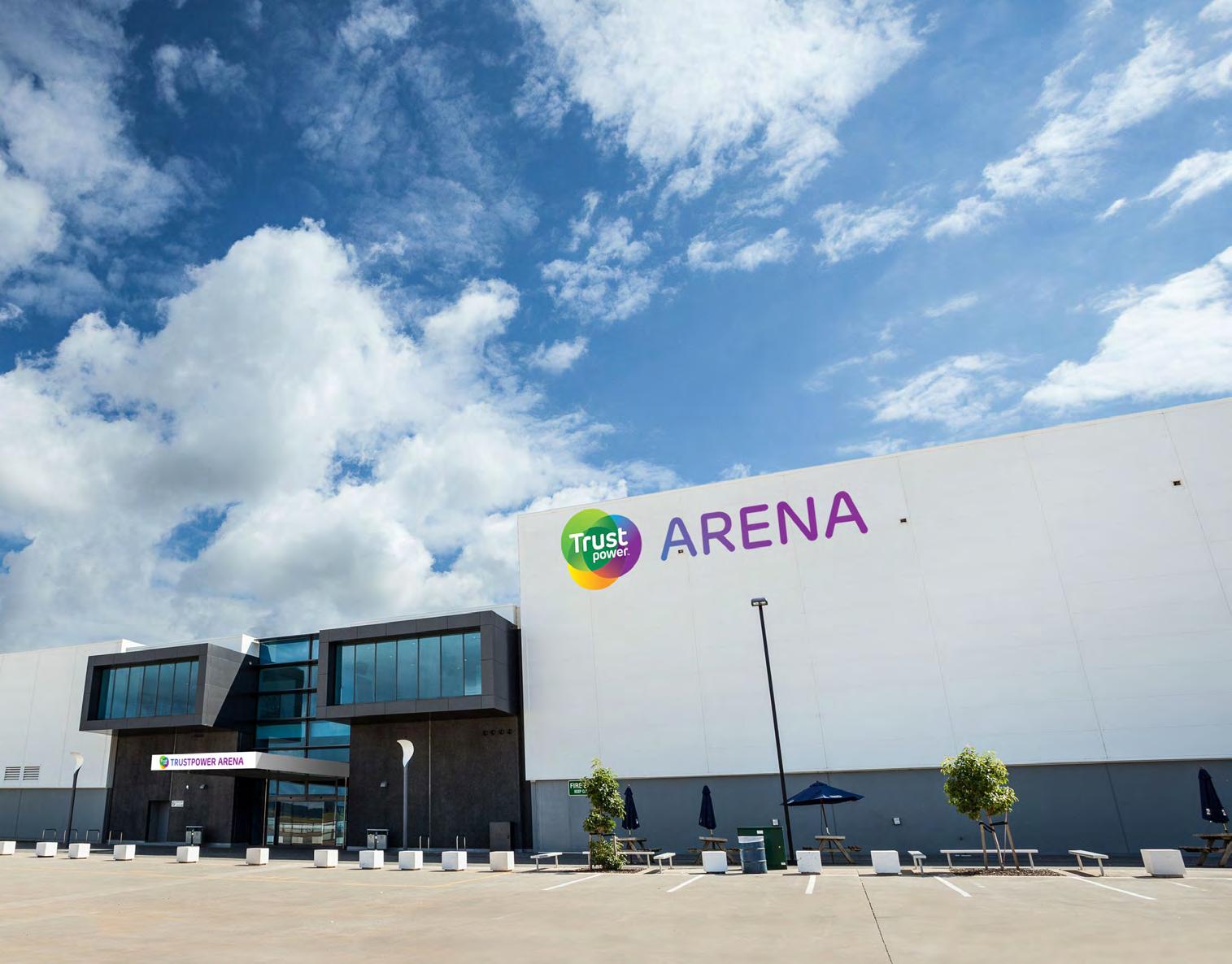





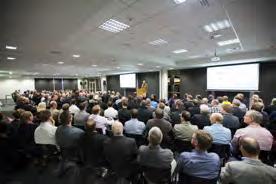


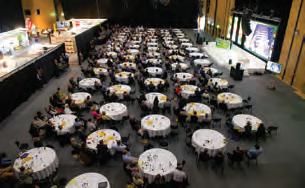


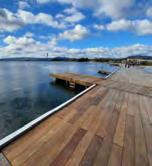











































































One of the most interesting political trajectories Bay of Plenty citizens have seen in local politics has been Western Bay of Plenty MP Todd Muller’s brief tilt at the National leadership and his recently announced decision to retire at the end of his term.
By DAVID PORTER
Muller recently spoke with Bay of Plenty Business News on the events surrounding his decision to leave active politics.
Muller was reluctant to go into too much detail over the spat with the National leadership, which seems to have been the trigger for the move. It has been widely canvassed that his relationship with National leader Judith Collins has not been close.
“The reality that became clear recently is that the relationship with the current leadership is not good,” said Muller.
“I don’t have a particularly good relationship between myself and the leader and it’s essentially broken down, but these things happen in your personal and professional life. I’m pretty open to other options.”
Muller handily won re-election at the most recent elections and is now finishing up what will be nine years as an MP.
“It’s just become clear to me that it’s time to apply myself outside of the [parliament] building at the end of my term,” he said.
“Nine years is a decent run. You’ve got to make sure you feel you can make a contribution in a way that’s in line with your values and your approach to life. And I think certainly over the last year I have found that pretty difficult.”
Muller in a shock move just over a year ago ousted fellow Tauranga MP Simon Bridges from the leadership, but very quickly succumbed to a severe anxiety attack and soon stepped down from the leadership role.
“I was determined to come back after that if I had the support of the
You’ve got to make sure you feel you can make a contribution in a way that’s in line with your values and your approach to life. And I think certainly over the last year I have found that pretty difficult.” – Todd Muller

BOP electorate, which I did. I got back on the horse and enjoyed campaigning and door knocking. Now as we come into a year and ending a third term, I’ve decided it’s time to move on.”
Muller emphasized that he would be using his remaining time in parliament to work towards helping accomplish the party’s goals.
“But I made my resignation decision with an increasing sense of excitement about what could be around the corner,” he said.
As Muller acknowledges, it is a matter of public record that he found the leadership battle “brutal and acute” and that he had an acute break-








down, which drew widespread interest and sympathy from a large part of his electorate.
Muller, who moved to Tauranga in 1970, has a long relationship with the area as had his late father who was a well-respected member of the kiwifruit industry.
Todd Muller has spent much of his working life in the kiwifruit and dairy industries and is deeply interested in agribusiness.
“I haven’t turned my mind yet to future work, but I have my focus very much on some key areas.”
These include the provision of mental health services in the BOP, and Muller is especially aggrieved that the
current government has not delivered on its initial promise to improve on Tauranga’s mental health provision, especially in growing Papamoa.
He is also concerned about the flawed nexus between housing and transport provision and how inadequate both have been planned for in this city.
“It’s a real frustration for a number of years that governments have not invested in the way they should have for this city,”said Muller.
“It’s as if we’re caught in a historic paradigm that we’re a little village out by the sea as opposed to the reality that we’re now 160,000 people and the fifth biggest city in the country.”








www.bopbusinessnews.co.nz
PUBLISHER
Alan Neben
Ph: 021 733 536
Email: alan@bopbusinessnews.co.nz
EDITOR
David Porter
Mob: 021 884 858
Email: david@bopbusinessnews.co.nz
PRODUCTION
Copy/Proofs/Graphic Design
Times Media – Clare McGillivray Ph: (09) 271 8067
Email: clare@times.co.nz
BUSINESS DIRECTOR
Pete Wales
Mob: 022 495 9248
Email: pete@bopbusinessnews.co.nz
EDITORIAL:
News releases/Photos/Letters: david@bopbusinessnews.co.nz
GENERAL INQUIRIES: info@bopbusinessnews.co.nz
Bay of Plenty Business News has a circulation of 8000, distributed throughout Bay of Plenty between Waihi and Opotiki including Rotorua and Taupo, and to a subscription base. www.bopbusinessnews.co.nz
Bay of Plenty Business Publications
309/424 Maunganui Road, Mount Maunganui, 3116
Bay of Plenty Business Publications specialises in business publishing, advertising, design and print media services.

BayparkArena is celebrating 10 years.
We are delighted to celebrate in this month’s cover story the continuing strength of Trustpower Baypark Arena as the imposing landmark celebrates its 10th year as an entity.
It hasn’t been easy for the management and staff, especially in the past year or so as the organisation has grappled with the consequences of Covid-19 and the difficulty of forward planning in such a volatile environment. Nonetheless they have continued to drive on, as have so many other companies in the Bay of Plenty, despite the difficulties of living with the extremes of the pandemic.
We went to print just before the Government announced its latest long-term survival plan for navigating the pandemic. This country is undoubtedly blessed, as we have remarked before, to be several thousand miles away from new sources of infection and to have a rather small population.
However, there is evidence that New Zealand’s leadership,
which has to date survived the global Covid-19 crisis better than most worldwide, is beginning to feel the negative impact of a now somewhat jaundiced electorate.
As reported last month, the latest Newshub Reid Research poll had ruling Labour down 9.7 points to 43 percent, while the National Party was up 1.7 points to 28.7 percent.
Perhaps not surprisingly, the ACT party scored its highest ever Reid-Research rating, up 4.2 points to 11.1 percent of the vote.
ACT leader David Seymour, always a shrewd politician, was quoted as saying that Labour’s loss was both ACT and National’s gain.
“The real story of this poll is both ACT and National rising,” said Seymour. “I believe that’s due to disillusionment
with the government’s performance on substantial issues, being housing, the Covid-19 recovery and law and order on the streets.”
The National Party remains a clear second in the poll, and while their boost was not as dramatic as that received by ACT, National leader Collins said she was happy with the results.
“ACT coming up is ultimately good for National because we’re also going up so it’s not as though it’s taking votes off us.”
ACT leader David Seymour was just as keen to talk up joining forces with National – pitching the parties had two years until the next election to close a 10-point gap.
Prime Minister Jacinda Ardern still clearly leads the

Research indicates that over the next three decades, huge investment will be required to ensure all New Zealand communities continue to have the safe, effective and sustainable water, wastewater and stormwater services they need.” – Anne Tolley
Community input sought on three waters reform proposal – p16
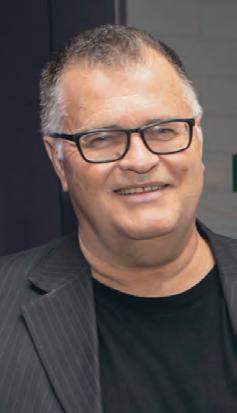
Given
transmit its version of how well it thinks it has handled Covid19, especially on television, with relatively little negative comment from the mass media, it is not hard to think that the latest poll may have sent a few shivers down the leading party’s collective spine.
LawVu is considered the leader in this space amongst many of the most tech savvy in-house legal teams in the world.” – James Cameron
LawVu receives fund injection – p15


The head of Port of Tauranga is cautioning that shipping delays and problems are likely to linger for many more months as the global struggle with covid continues.
By RICHARD RENNIE
Leonard Sampson, Port of Tauranga CEO said the greatest impediment to smooth cargo handling at the port in past months has been the increase in ships failing to keep to arrival schedules.
“Typically, we would have three company services a week on the Asia-Australia-New Zealand route, and so that service required about six vessels over a 49-day rotation.
“But at present that rotation is 63 days, with no more vessels coming on. This equates to eight-to-nine less sailings a year – over three companies that is 24 less a year.”
Less container vessels docking
But he said Port of Tauranga has had 106 less container vessels dock between October last year and July this year, due to delays and scheduling changes. “So capacity is down, but the demand is still there.”
This has been accompanied by a “very strong” July for container demand, despite July typically being the low point of the exporting season.
Globally shipping schedules have reportedly fallen to all-time lows for reliability, with New Zealand schedules for most ports reported at only five-to-six percent accuracy, compared to historical averages of 80-90 percent.
POA delays
Sampson said limitations at the Port of Auckland had also hampered Tauranga’s ability to maintain container flow, with some ships only partially discharging cargo there, instead delivering it to Tauranga and requiring it to be trucked back to Auckland.
The particularly high number of containers deposited on Port of Tauranga land at present is due to lack of storage space in Auckland.
Marty Verry, chief executive of Rotorua timber processor Red Stag, which exports to Asia, Africa, Australia, Europe, and the US, said exporting has been particularly problematic in recent months.
“And it seems to be getting worse.

The supply lines never got a chance to disentangle and run smoothly last year when Covid hit before the world starting booming and demanding more products, leading to a massive increase in demand. This was led by the United States.”
Major increases in the pipeline
While still on a contracted rate for shipping, he anticipated some major increases once the contract ended.

The Baltic Dry Index, an indicator of global shipping costs, has just hit its highest level in a decade and more than double what it was a year ago.
Shipments to Australia have been particularly problematic, either delayed, “bumped” or interrupted. The delays were making filling orders difficult, with customers often forced to accept only partially complete orders in a country also struggling to source sufficient timber for construction.
David Ross, chief executive of freight company Kotahi said the majority of American and European ports are suffering from prolonged berth delays and high levels of port congestion.
Many ports throughout China are also heavily congested and gridlock every time Covid resurfaces there.
He said New Zealand’s shipping schedules are lower than the global average reliability of 39.1 percent.
“The Port of Auckland’s challenges with port congestion and shipping schedule reliability continues to disrupt shipping schedules for New Zealand ports.
“Their automation project has been paused to try get ahead of these challenges, however these conditions are expected to last until mid-to-late next year.”
He anticipated New Zealand
The world’s largest shipbuilder, China State Shipbuilding Corp hit its 2021 annual target in only six months this year, while demand for bulk freighters has jumped 140 percent.”
would continue to see pinch points on capacity to some regions over the coming 12 months.
Working with Maersk, Kotahi has managed to reduce congestion by adding additional capacity.
Challenges in the system
Ross acknowledged that for exporters of chilled products the current supply chain conditions are a challenge.
“We work with our strategic partners to ensure our customers’ chilled products aren’t further delayed, by focusing on what we can control such as equipment supply, capacity availability and ensuring their product gets off the port and onto a vessel.
“Through the strength of our collaboration with partners, we have been able to keep our customers’ product moving, however it’s been hard yards.”
Leonard Sampson said he did not believe the congestion and delay issues were a “this year, next year” issue, something Marty Verry agreed with.
“This may be something that is likely to continue to be with us for the next two to three years,” said Verry. Sampson said capacity balance was unlikely to be achieved until either more ships were commissioned, or the world returned to a point where consumers spent more on services like tourism, rather than goods that require freight capacity.
The world’s largest shipbuilder, China State Shipbuilding Corp hit its 2021 annual target in only six months this year, while demand for bulk freighters has jumped 140 percent. Sampson said this came after a record number of vessels were reported anchored and idle only 14 months ago.
There’s no shortage of great ideas in New Zealand. But for an innovative bunch, we’re not the best at realising the full potential of our innovations, particularly when exporting them.
At James & Wells, we can identify your competitive edge, offer business strategies for specific markets and help you own and leverage your intellectual property to ensure no one steals the fruit of your labour.
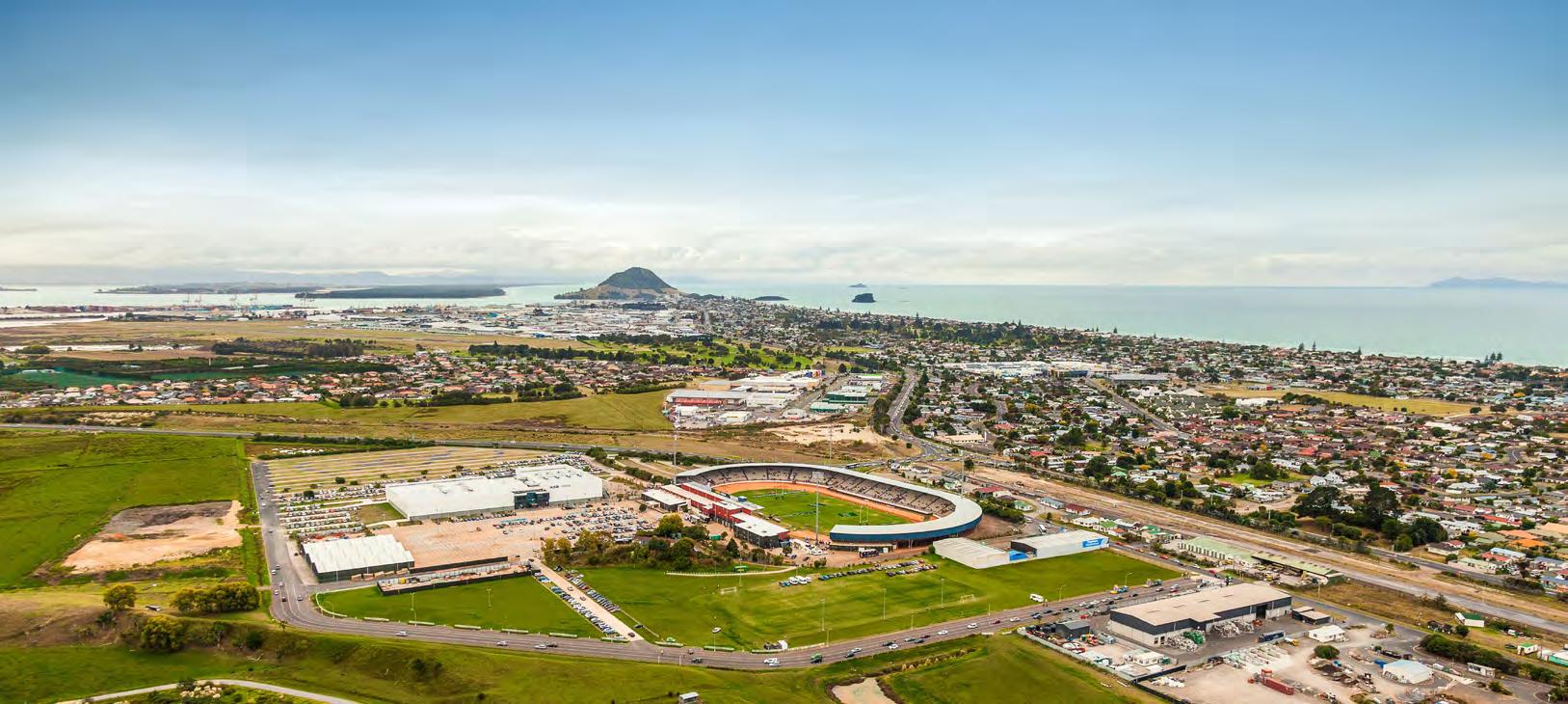
Trustpower Arena at Baypark is celebrating ten years of activity since opening in late August 2011
By 2005 the need for a new recreation, event and exhibition space for the growing city of Tauranga – which at the time had a population of approximately 100,000 –was identified. At the time there were several single court facilities dotted around the area in addition to the QEYC. There was also the Mount Action Centre and a four-court facility in a converted storage warehouse – these were a gauge of the city’s requirements for more court space.
Meanwhile Baypark speedway had been re-established at the Baypark site on Truman Lane. The site boasted some 17 hectares of useable space, had great carparking and was a relatively central location.
The decision was made to build a new facility, initially named TISEC – Tauranga Indoor Sports and Exhibition Centre – at Baypark. It was intended to be a multipurpose facility for the region, accommodating community sports and other events.
Research was undertaken in contemporary
venues throughout NZ and a concept was settled upon. Architects and contractors were engaged and in early 2010 the first earthworks commenced, officiated by then Mayor Stuart Crosby.
On time and within budget
In late August 2011 the new venue, named the TECT Arena to recognise TECT’s financial contribution to the project, was opened, on time and within budget – testimony to those managing the project.
The first event was the NZ Wrestling Championships, followed soon after by the massive Police Charity Luncheon, the first catered event in the new venue with just over 1000 people in attendance. Community sports such as netball, basketball, football and volleyball soon followed. The community immediately responded with over 250,000 users in the first 9 months of operating. This figure grew to one million visitors in early 2014 (in
July 2021 visitors numbered 4 million).

Although something of a ‘baptism of fire’ for the operators, the launch was a huge success and the venue has gone from strength to strength since that time. Since opening patronage has increased every year (until rudely interrupted by the covid outbreak in 2020).
Build it and they will come
The classic, “build it and they will come” approach applied perfectly to the venue development. It has provided opportunities for a vast range of community participation events and event promoters, sports administrators and business organisations have brought a vast range of entertainment and commercial activities to the city.
The Arena has on many occasions hosted the Silver Ferns and netball tournaments, international basketball fixtures, NZ bas-
ketball finals, NZ gymnastics, NZ weightlifting, NZ wrestling and volleyball championships. One of the early highlights was the setting up of an indoor tennis court for an international tennis Davis Cup match.
Meanwhile the demand for community sports and activities continues to grow with major local, regional and national tournaments a feature of the calendar.
The venues contemporary design has seen it stand out and ten years after opening it still represents the high-water mark of such facilities in NZ. It is however now bursting at the seams with the growing population and associated increase in demand for space; The time is now right to expand the city’s amenities further. Planned expansion now could be every bit as inspirational as when the Arena was originally launched.
Tauranga City Council, shareholder of Bay Venues Limited, is delighted to wish Baypark Arena and its staff a very



Bay Venues plays a major role
The Trustpower Arena is not only home to local indoor sporting codes, it also hosts numerous regional and national tournaments.
Almost every day the six-court side of the venue is abuzz with a variety of community activities.
Most weekday mornings start off with Tumble Time, a play-based programme for pre-schoolers, where the number of caregivers and toddlers can be up to 100 per session. During the day the courts can be filled with primary school-aged children attending one of their favourite outings, Funky Fun Days, where the Arena programmes team facilitate a range of sporting, recreational and play activities which have school students coming back for more each term.
Space for people to drop in and shoot hoops
On other days Pickleball, or Walking Basketball take centre stage, both sporting activities for active retirees with space for people to
drop in and shoot hoops.
The afternoons attract teams of youths turning up to play basketball or volleyball.
Then come the evenings when secondary school students and adults get their chance to participate in their chosen indoor sport, be it basketball, netball, volleyball or football.
Alongside the traditional structured sporting codes, locals can also participate in payfor-play sports leagues – a great way for groups of friends, families or work mates to participate in social sport.
Sporting groups like Tauranga City Basketball have grown from strength to strength since the opening of Trustpower Arena.
When the facility was first built, basketball occupied the space just one or two nights a week, but now basketball is being played every weekday during autumn and winter and often in the weekends.
Arena hits the mark for AIMS games
A feature of the annual calendar is the AIMS games, which utilises all the Arena spaces for




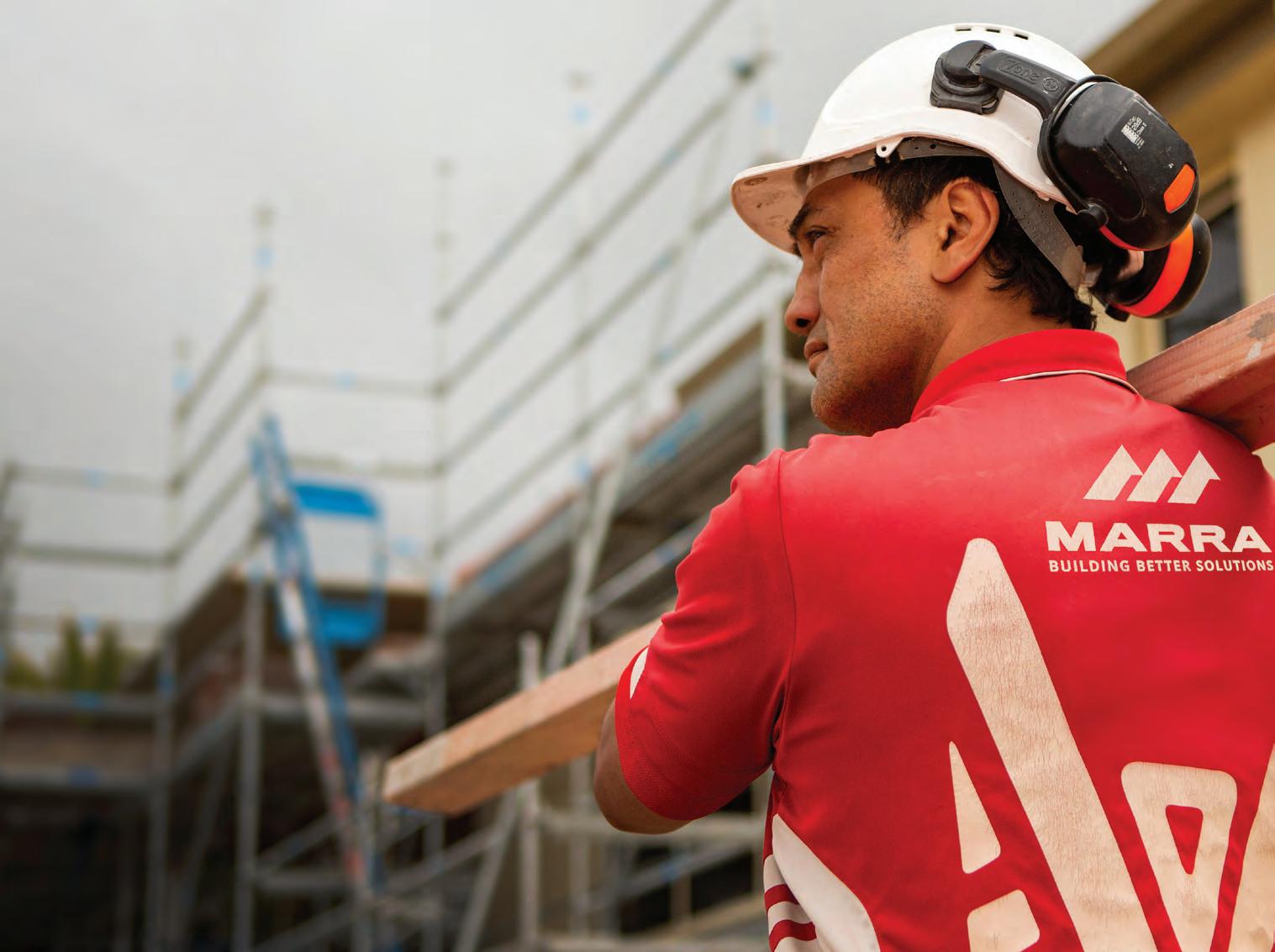
We are proud to celebrate this milestone achievement with the Arena and the integral role they play in supporting our local communities.
The multi-use portfolio of Trustpower Arena is evident in the growth of busi ness events.
The Arena is promoted strongly through various commercial industries and hosts large expos, national conferences, numerous meetings, awards dinners and celebration events.
As well as the state-of-the-art Lion Foundation Centre for expos, functions and plenary sessions for conferences, the Arena boasts purpose-built suites for break out rooms to compliment any business event. The suites are also preferred spaces for many local business meetings. The variety of events cater for young families through to seniors.

Attendance at all the business events has increased annually and post 2020 covid lockdown there has been on average a 30% increase in numbers to the variety of events such as Tauranga Home Show, Seriously Good Food Show, Wedding Show
and Armageddon.
Notable national conferences also feature prominently, such as Zespri Momentum, Stormwater NZ, Fire protection NZ, and NZ Bridge Congress and Competition; All bring large numbers of people to Tauranga and the area.






he level and variety of entertainment has grown substantially since opening in 2011. Initially, with the Arena being a new regional venue, concert promoters needed to gain confidence in the mar ket. Despite small beginnings, the range has broadened and the number of concerts has grown to around 20 per year – and this could be an even greater number if more short-notice dates and spaces were available for promoters.
Trustpower Arena has also played a large part in the Summer Bay Dreams Festival. Some highlights have been the sold-out concerts by the Beach Boys, Dr Hook and the Hollies, showing that there is a
market for the nostalgia of yester-year.
The entertainment mix has included a diverse range of both international and New Zealand artists – Sol3 Mio, Jimmy Barnes, Bill Bailey, Dionne Warwick, Slash, Stan Walker, 7 Days, Devilskin, Kora, Katchafire, The Feelers, Dragon, Broods, Good Vibes Winter Festival, Blindspott, Tones & I, Sticky fingers, Macky Gee, Kanine and more – have all played in the Arena. Trustpower Arena has been turned into a theatre for productions such as Madagascar, Merchants of Bollywood, Saturday Night Fever and The Sound of Music. The success of these productions indicates that the community enjoy the entertainment the Arena is able to provide.
The future is bright for Trustpower Arena with back-to-back events and bookings through until 2025. The community can look forward to activities and many exciting events to come.


If there’s one person you need to talk to about what makes Trustpower Baypark Arena tick, that person is probably Bay Venues commercial manager Ervin McSweeney. Ervin has been commercial manager of the facility for seven years. Before that he was CEO of Baypark’s former council operator, Tauranga City Venues Ltd
By ALAN NEBEN
Ervin explained to me the earlier history of what he affectionately terms the ‘long journey’, when the old Baypark area was largely taken over for residential housing and Baypark raceway and stockcar track was replaced by the new stockcar track, ultimately resulting in the Baypark we see today.
In 2005 the decision was made to build what is now Trustpower Baypark Arena. Construction commenced in February 2010 and the building opened a year and a half later.
Hawkins Construction was the lead contractor for that project.
According to McSweeney, “the Arena is in superb condition, particularly considering the number of people who have used it over the last 10 years.”
“It really has proved to be a fantastic facility,” he says with a certain degree of pride.
Is there need for expansion? McSweeney is quite objective: “The numbers say it all –the sheer volume of users is evidence of the demand. That demand has clearly been identified and continues to grow and grow.”
He points out the venue has also provided a lot of opportunities for the community to be involved in numerous ways.
He estimates that in early July 2021 the Arena welcomed its 4 millionth user – not an insignificant number by any standards.
Operationally, a facility such as Trustpower Baypark Arena, with users numbering in the millions over a few short years, requires a skilled team of personnel; The Arena activities are broadly divided into two categories: the community sports and events,
and the business activities. Servicing these broad categories is a catering team, a production team, venue and event operations staff, and the set-up and take-down staff who make the venue presentable. At any one time there can be 50-60 people working directly on an event – where there are very big events on, this number can be far bigger.
– Ervin McSweeny
“It’s one thing having some walls and a roof, but it’s what happens inside that counts”
“Big events give us the opportunity to ultimately offer employment to large numbers of people, if not directly by us, then certainly enabled by our provision of the facilities –consider the labour force required to serve a meal for 600 people at an event for example, or at the other end of the scale, the numerous referees and support people who are needed to organise and officiate at community sports events held regularly at the arena.”
“But it is far more than a building. It’s one thing having some walls and a roof, but it’s

what happens inside that counts.”
“I think that’s where the Arena really has provided such a fantastic facility for the community to enjoy,” says McSweeney.
The fact that the usage numbers have grown as dramatically as they have in recent years is proof of the demand.
“From a commercial business perspective, our facilities are leading edge. Businesses often need a turnkey solution for their business events, from training days, client and supplier functions or exhibitions to conferences and shareholder meetings – we have it all covered. We have a support team that really does it well with provision for business requirements of all types,” he says
“It’s just a great experience for a lot of people”
The Trustpower Baypark Arena now regularly hosts music and entertainment events that, until the arena was built, would never have come to the region.
In particular McSweeney points to the Beachboys concert, the Davis Cup tennis tie and international basketball and netball games as absolute personal highlights for him.
“From ‘Tumble Time’ for the tots, to pickle ball played by seniors – it’s just a great experience for a lot of people,” he says. As for suggestions that extensions to the arena may come to fruition sooner rather than later, McSweeney is hopeful: “The work is being done on looking at the city’s needs, demand has been identified, so we look forward to seeing developments.”
His verdict so-far: “What a good investment it was; A very good decision was made by Council all those years ago.”
Considering it has only been 10 years, to have built and grown a facility that is now unequivocally regarded as a success and a key foundation for the community really is remarkable.

Last month Trustpower Arena hit double digits. Unfortunately the latest Covid-19 developments got in the way of our celebrations, but we will be doing our very best to ensure that all of our visitors are catered for. However, please note that although information on planned events previewed here is the most accurate available at the time of publishing, Covid restrictions may necessitate changes to scheduling. We recommend you check online for the most recent event updates.
Women’s Lifestyle Expo 2021
Do you need a girls’ day out? The Women’s Lifestyle Expo is a two-day event for woman of all ages, featuring everything from fashion and beauty to health and fitness, artisan good, gourmet food & beverages and much more!
This is the only event of its kind happening in nine regions across New Zealand so grab your girlfriends, sisters, mum, grandma or daughters for the ultimate weekend at the Women’s Lifestyle Expo on Saturday 18 & Sunday 19 September.
Tickets are just $10 at the door, or get a 2-for-1 deal on GrabOne in the lead-up to the show! Kids under 12 are free.
Stan Walker – All in Tour
With no need for introductions, Stan Walker embarks on his nationwide ‘ALL IN’ tour performing 9 spectacular shows across Aotearoa, singing all
of his hit songs and some brand new music!
Joining Stan Walker on his headline tour are renowned Kiwi artists Kingz, Louis Baker, Hamo Dell and rising star Crete, guaranteeing a show like no other that brings the WOW factor – a concert sure to impress fans of all ages!
Stan Walker’s ALL IN tour marks the resurgence of his first headline tour in two years. With his unparalleled powerful performance style that captivates audiences with his entrancing vocal ability and personable humour, Stan’s new show will reach new heights taking it to another level!
Join Stan Walker, Kingz, Louis Baker, Hamo Dell and Crete on 23 September to experience a night of unforgettable live music. Tickets on sale www.ticketspace.co.nz.
NZ Bridge – NZ National Bridge Congress
After the disappointment of not being

able to hold a National Congress in 2020, there will not just be a new venue but many other changes as well.
The 35th New Zealand National Bridge Congress is the premier bridge event in the annual calendar and was last attended by over 700 players in 2019. In 2021, it will be held from Saturday 25th September to Saturday 2nd October 2021 with events open to all levels of players, from grand-master to Novice players.
It’s never too early to start thinking about Christmas
It’s that time of year again when your work social committee starts to brainstorm ideas for your staff Christmas party. What have we done before? How can we make it better than last year? Sure you could invite everyone to the conference room for drinks, or go out for dinner – but that’s all been done before.
Why not celebrate the festive sea-

son at Baypark this year and indulge in a delicious Christmas feast created by our award-winning Executive Chef? Why not make your party extra special and visit BayStation and enquire about Drift-triking or Blokarts? For info or to book ph 07 577 8560 or email events@bayvenues.co.nz.
Tauranga’s Premier Venue
Trustpower Baypark is Tauranga’s Premier Venue for conferences, meetings, entertainment and exhibitions. Offering a complete package in one convenient location that features state of the art meeting rooms, in-house catering, audio visual services, professional conference organiser (PCO) and marketing/promotional services.
For more information on any events, enquiries for Trustpower Baypark venues, BayStation activities or service on/off site from BayCatering, BayAudioVisual visit www.trustpowerbaypark.co.nz or email events@ bayvenues.co.nz.


Proud service provider to the Trustpower Bay Park Arena & Tauranga community for the past 10 years
As New Zealand’s leading provider of turf, parks and facilities management, we maintain, create and manage parks, landscapes and sports surfaces across Aotearoa.
At the Trust Bay Park Arena, we proudly maintain the on site green spaces and have completed various large pitch transformation projects to an exceptional standard. This includes converting the pitch from a jet boat event to a National Provincial Rugby rugby field.
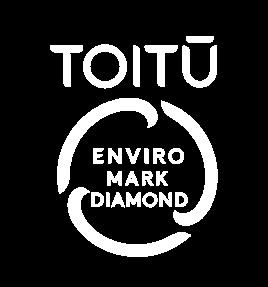
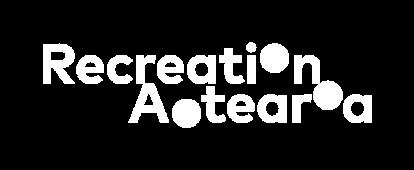
Investment market update (for the quarter ended 31 July, 2021)
Globally, the majority of share markets continued to climb higher, with many sitting at or near record highs. Markets have been driven higher by a combination of:
• Companies generally delivering better-than-expected earnings results benefiting from a combination of improving economic activity and significant cost savings.
• Central banks and governments remaining committed to “loose” policy settings, including ultra-low interest rates, which continue to underpin very healthy growth in economic activity, and support demand for higher risk-return investments such as stocks.
• Vaccine roll-outs in Europe and the United States boosting hopes that rising cases of the Covid-19 delta variant will not lead to further lockdowns. Vaccines have proved effective in substantially reducing the proportion of people who catch the virus getting seriously ill.
New Zealand has remained a laggard
The New Zealand market is dominated by defensive dividend-paying stocks, which many investors look at as an alternative to fixed interest investments such as bonds or term deposits. The firming in long-term interest rates over the past nine months has generally been a headwind for these stocks.
The Reserve Bank of New Zealand (RBNZ) likely to lead interest rate hikes globally
Until very recently the message from our own RBNZ was consistent with this “wait and see” approach. But, in the past month, the outlook has shifted sharply. It now appears to be a two-horse race between the RBNZ and Norway’s Norges Bank as to who will be the first

> BY BRETT BELL-BOOTH
Investment Adviser with Forsyth Barr Limited in Tauranga, and an Authorised Financial Adviser. Phone (07) 577 5725 or email brett.bell-booth@forsythbarr.co.nz.

developed market central bank to hike rates in a post-Covid world. There are a number of reasons we believe the inflation we are seeing in New Zealand is likely to be stickier (and therefore more concerning for the RBNZ) than in other countries:
1. Whilst the rest of the world has been grappling with restrictions and lockdowns, New Zealand has largely (with the exception of tourism and border movements) been in a post Covid-19 economy since the middle of last year. Consumers — without the burden of Covid fears — have responded to ultra-low interest rates by breaking out the credit cards.
2. The New Zealand economy is facing pent-up demand and capacity constraints — the housing shortage being the most obvious example — from the tidal wave of

migrants over the last eight years. In recent years, that same migration kept a lid on wages. But now, with borders shut, capacity pressures are biting.
3. New Zealand is a small, open economy a long way from most trading partners. The delays in supply chains and dramatic jump in freight prices are disproportionately impacting import costs for our businesses.
Invest locally and globally
Over the past decade or so, a home market bias to New Zealand would have been very beneficial. Our high dividend yielding market has been one of the top performers globally.
A large part of this return has been from investors’ willingness to pay a higher price for the income generated by businesses in sectors such as utilities, telecommunications,
and property. We believe the shift in the direction of interest rates means this benefit is now likely at end.
That isn’t to say you should throw the baby out with the bathwater. There are still high-quality companies in New Zealand we are happy to remain invested in. But, it does mean having adequate diversification (always a mainstay of any investment plan) across markets and sectors may prove even more important than usual. As always, whether regarding adequate diversification or any other questions you may have, your Forsyth Barr Investment Adviser is available to discuss your investment plans at any time.
This column is general in nature and does not take any of your personal circumstances into account. For personalised financial advice, contact Forsyth Barr for an overview of the services we can provide.

Opōtiki District Library has joined the growing number of libraries in New Zealand and around the world that are shelving the ‘odd and outdated’ notion of fines on books returned late.
Ōpōtiki library manager, Jo Hunt, said that existing fines have been wiped and no further overdue fines would be issued although there will still be charges to pay for replacement or damaged books.
“Our library is such a valuable part of the community. Our services open up doors to information and expertise for learners of all ages. We support digital literacy, a place to do homework, a place to do work-work, and of course reading for pleasure and social connection.
“I would hate to think for one second that a punitive measure, like a fine, was a barrier to anyone accessing library services.
“Libraries that go finefree here and internationally, note that overdue fees do nothing to incentivise people to return their books, but probably have the reverse effect – keeping people away either because they have overdue fines they can’t pay or worry that they could end up with fines against their name,” Ms Hunt said.
Increasingly, libraries are deciding that fines are inconsistent with the out-
comes that libraries work towards – equal access to resources and information for everyone.
Research shows that people will stay away from a library if they don’t want to pay a fine, which has the reverse effect of a book never being returned, rather than just being returned a couple of days late.
Ms Hunt also pointed out that fines are not a significant part of the library funding, and in fact usually cost more to chase and administer.
“Libraries are paid for through rates, like sports fields and playgrounds, so that the whole community has facilities they can use and benefit from.
“Of course, fines aren’t how we fund our building or new resources or staff time, so they don’t add anything except put up an unnecessary barrier.
“At any point in time we probably only have a small handful of overdue books, so they are not a significant problem,” Ms Hunt said.
“Our way of working is to stay in close contact with our borrowers –checking in, sending text reminders and offering loan extensions rather than penalty charges.
Removing fines means that all borrowers, existing and new, can relax, borrow and enjoy the resources,” Ms Hunt said.

Some 27 years ago I walked into an office for my first accounting job and a couple of weeks later I was hooked. I loved everything about it: the numbers, the challenge, and especially the people. That was back in Russia (my home country) – today I live in beautiful Tauranga and have done for almost 20 years.
After so many years of working with business owners, I have noticed how hardworking and determined business owners are; I see my job as helping business owners to see the bigger picture.
We often discuss business strategy, goals, and aspirations. I cannot stress enough how important it is to read and understand your business numbers. Your cash flow can often tell us if you are winning or losing.
To put it simply, I aspire to be your trusted adviser, who is looking out for you, assisting you in any way possible. Sometimes I am your critic, but mostly, I am your biggest cheerleader.
You may have heard about the Government’s Clean Car Program which is part of our gov-
ernment’s response following the Climate Change Commission issuing its recommendation in May 2021. The Commission was formed in May 2018 and provides independent, evi-
electric or plug-in hybrid vehicle you will be given a cash rebate of up to $8,625 for a new fully electric vehicle and $3,450 for a used vehicle. For a new plug-in hybrid you will be given a rebate of


If you purchase a new or imported second hand electric or plug-in hybrid vehicle you will be given a cash rebate of up to $8,625 for a new fully electric vehicle and $3,450 for a used vehicle.”
dence-based advice to government on climate issues.
Following the recommendation, on 13 June 2021, James Shaw and Michael Woods announced the Clean Car package. In essence, if you purchase a new or imported second hand
$5,750 and $2,300 for used import.
Current approved rebates are applicable from 1 July 2021 to 31 December 2021 and will be reviewed every year. The rebates will also expand from 1 January 2022 to include low emission vehi-
> BY VALERIE ROWE-MITCHELL
Accounting and other money matters with Valerie Rowe-Mitchell, owner of Emerald Business Advisers. Valerie can be reached on 07 579 5777 or valerie@emeraldbusiness.co.nz
cles, like the Suzuki Swift and Honda Jazz.
To claim a rebate, you will need to apply via the NZTA website and provide a copy of the vehicle offer and sale agreement, proof of the registered person’s bank account, and your GST number (if the vehicle is being used for business purposes).
What about the fees?
The most popular question is about the fees – when, and how much will I be charged if I purchase a petrol vehicle after 1 January 2022?
A new survey commissioned by Registered Master Builders for its annual Constructive Forum highlights key issues facing the building and construction sector:
• 95% of respondents reported issues with increased costs, delays, customer complaints and product substitutions due to a lack of available building materials.
• 88% reported that stress and mental wellbeing was a significant issue
• 70% of respondents say it’s harder to get the staff they need now than it was 12 months ago
The Registered Master Builders Association’s annual State of the Sector Survey has revealed that while the building and construction sector is optimistic about its business prospects and the economy, reflecting the current boom, it is facing huge constraints and challenges.
Released at this year’s Constructive Forum, the survey identifies the biggest challenges and opportunities facing the building and construction sector. Over 300 industry leaders from across the sector responded to questions about the economy, critical issues the sector is facing, and their outlook for the sector.
Master Builders Chief Executive David Kelly said that respondents were asked to rank the most critical issues impacting their businesses in 2021.
“The three most important issues were: the supply chain disruption, product availability
and increasing product substitution; the rising costs of construction; and, acute skilled labour shortages. The sector is stretched to breaking point, largely due to factors outside its control.”
After all, they live in the communities where they work so they’re at the front line delivering the homes that New Zealanders desperately need.”
“They like the rest of the community also have to navi-
If every one of our members’ building projects is delayed by even one week, collectively our members and homeowners are incurring almost $100 million per annum in lost profits and extra costs.
These issues are imposing significant stress on builders, with 88% reporting that stress and mental wellbeing was a significant issue for them.
David Kelly expressed his concern, “It is worrying but not surprising that our workforce is feeling under stress.
gate the stresses of Covid. And they have the added uncertainty, even in boom times, that it can’t last, and the industry does suffer hugely when it changes.”
The survey also found that finding skilled staff is an acute problem for the sector.
Almost 70% of respondents say it’s harder to get the staff they need now than it was 12 months ago, with 37% say that it is substantially harder.
“Finding skilled staff has been in the top three issues since we began the survey in 2018. The sector is crying out for experienced people across a range of specialist areas. Uncertainty around immigration settings only exacerbates this situation,” stated David Kelly
“This is also more complex than many people realise. While training is an important piece of the puzzle – it will not solve the problems we have today. We need experienced skilled workers, and they are competing for those people with other countries and sectors.
“The Government’s apprentice boost scheme has been appreciated, apprentice numbers are at an all time high and we are pleased to see more
Fees will be charged on higher emitting vehicles and will start from 1 January 2022 when they are first registered in New Zealand. For example, the fee for a Ford Ranger will be in the region of $2,780. A Toyota Hilux will attract a fee of $2,900. I assume the fee will be paid by the dealer if they are registering a vehicle and most likely be passed on to the buyer, or the fee will be charged to an individual who is registering the vehicle in New Zealand for the first time.
Will there be any exemptions?
Yes, agricultural vehicles for farms, such as tractors, harvesters, mowers, toppers, bailers; military vehicles; special interest vehicles; vintage and veteran vehicles; scratch- built vehicles and modified vehicles certified by the Low Volume Vehicle Technical Association Incorporated will be exempt from the Clean Car Program. Check out https://www. nzta.govt.nz/vehicles/cleancar-programme/ for more info. Feel free to get in touch, I would love to hear from you.

employers commit to training. This is a vital part of the puzzle to ensure we have the skilled workers we need in the future, but it is not the complete answer today.”
Supply chain disruptions and consenting issues were also highlighted as barriers to building. Cost escalation, building delays, and customer complaints were reported by 95% of respondents.
Consenting delays are also a huge problem according to David Kelly, “More than half of our respondents are experiencing delays of longer than three weeks for consents, more than five days for inspections and three to four weeks longer for code of compliance. These delays affect both builder and customer.”
“If every one of our members’ building projects is delayed by even one week,
collectively our members and homeowners are incurring almost $100 million per annum in lost profits and extra costs. This is a phenomenal number, especially when you consider that just a one week delay is very conservative. This is a key part of our productivity conundrum and will be a key focus for the Forum this year.” The annual Constructive Forum is an industry led effort to enhance collaboration, build resilience, and ensure a vibrant and sustainable sector that delivers for New Zealand. Its purpose is to bring the entire supply chain together, from Government, finance, land, design and build, and key enabling sectors such as research, training, and regulation to work together and identify ways to lift performance in the sector.
Franchisee entrepreneurs are attracted to buying a franchise business for a variety of reasons including brand passion or wanting the support and guidance of an established business system. Universally, people invest time and effort into a business with an expectation of a financial return.

The conventional approach has broadly been one of two options depending on the individual’s risk profile, experience, and capacity to build and develop a business.
The first, invest into a new or greenfield opportunity –grow the business and hopefully enjoy both positive cash flows generated by a profitable business, and capital gains over time by increasing the value of goodwill. By and large franchises grow their footprints on this platform with franchisee entrepreneurs.
The second approach is to purchase an established well-performing business with a proven trading history. This tends to attract franchisee entrepreneurs with a lower risk profile.
They have the benefit of being able to see the history and performance of the business, and in many cases it can
be an easier operational path to follow. They are of course making an assumption, and assuming an associated risk, that they will be able to maintain the performance of the business, continue to enjoy the benefits of the business’ profitability and protect the goodwill component.
The less-appreciated approach
There is a third and very neglected option for franchisee entrepreneurs, and one that I would suggest provides a number of potential upsides versus the two traditional approaches – this is to purchase an underperforming or even unprofitable franchise business. This sounds like it flies in the face of the universal objective of generating financial returns, but first we need to look at where and how financial return is generated.
What’s driving performance and can it be altered?
The incomparable advantage of buying into a franchise system is the ability to see and use benchmarking information.
Independent businesses may have industry benchmarking, but a good franchise system will have not only an abundance of benchmarking information but more importantly, an understanding of what and how these outcomes or measures can and are influenced.
When looking at an underperforming business, the potential franchise purchaser needs to ask the questions: is it a good system, how does this business unit perform against others, what key performance indicators are out of kilter, and can I influence these? Is it sales, a goods management or cost of goods issue, or is it

> BY NATHAN BONNEY
Nathan Bonney is a director of Iridium Partners. He can be reached at nathan@iridium.net.nz or 0275-393-022
wages or perhaps fixed costs that can be improved?
The franchisee factor cannot be underestimated and if the purchaser is able to align the performance of the businesses KPIs to the systems benchmarking, just a small number of factors could move the needle of profitability from red to black.
For a vast majority of businesses, once established, their value is a function of their profitability or goodwill.
Unfortunately, an underperforming business will often sell for less than its asset value.
This creates two opportunities for the purchaser; firstly, they can acquire the business for less than what it would cost to establish it.
There are additional potential cash flow and establishment cost savings.
Perhaps more substantial is the franchisee’s ability to improve goodwill and the relationship this will have on business value.
Improved profitability creates goodwill which can create an opportunity for capital gains, for some business this can be substantial and create super return to investment ratios.
Made all the more attractive as in most cases there would be
no capital gains tax if or when the business is sold.
Against this backdrop, I am not surprised that certain franchise systems have franchisees that are known as turnaround specialists who have bought and sold several businesses improving them along the way. As greenfield opportunities shrink in some established systems and as well-established profitable business opportunities decline or command higher prices, I would not be surprised to see an increase in the skilled and less risk adverse franchisee entrepreneurs backing themselves and successful brands to take advantage or franchised turnaround opportunities.
By ANDREW TAYLOR
There’s reason for the wide-spread dependency on tools like Microsoft Excel. Being a universally recognised application, it is accessible to most users in any sized organisation, has excellent functionality and, importantly, it is inexpensive. However, the perceived low cost operationally of using spreadsheets to manage company-wide quality processes turns quickly into high overheads when Excel is applied outside of its capabilities.
Spreadsheet hazards
If you recognise some of
these painful spreadsheet moments, you are not alone; ambiguity with the master document, left wondering what the current version is; multiple editors whose individual habits differ in their quality of formula creation; inaccuracy from manual entry and rekeying; broken spreadsheets as links and complex file structures fail.
Time spent re-learning or modifying spreadsheets when someone leaves is not often measured but builds up fast. As there is no automatic or standard approach in Excel for debugging, mistakes can remain hidden.
Spreadsheets do have their proper place in business man-


agement because of all the reasons they’ve become such a pervasive tool – accessibility, user familiarity, functionality for displaying, analysing, and conveying data.
But being reliant on multiple spreadsheets as the source

for timely, accurate information carries a load of risk that leaves you vulnerable, without the ability to audit the process efficiently.
Incident Management
When the pressure is on, as it is in incident management – complaints, audits, Health & Safety or repairs & maintenance – you need assurance the source of your information is accurate, and the reports get generated fast. When faced with an incident, if not using spreadsheets for converging all the critical details, then what are the affordable tools for tracking, response, and control?
Integral’s compliance register application, ICRA, gives the ability to have that one source of truth. Schedule and monitor workflow by company, site and team members via dashboards and emails.
Trace issues by category, product and production batch. Attach documents, photos, investigation and close out details to incident. There’s potential to integrate with ERP, Production, CRM and other applications. You’ll have peace of mind that the spreadsheet data that falls out is reliable leading to sound decisions.

At Integral we are intent on delivering businesses control, simplifying informa-


tion management and data integration. We can show you how taking your current spreadsheets and loading them into cloud-based applications will smooth business process and take a load off your mind.
Connect with Integral
0800 002 555
Visit icra.integral.co.nz
Email icra@integral.co.nz

0800 002 555
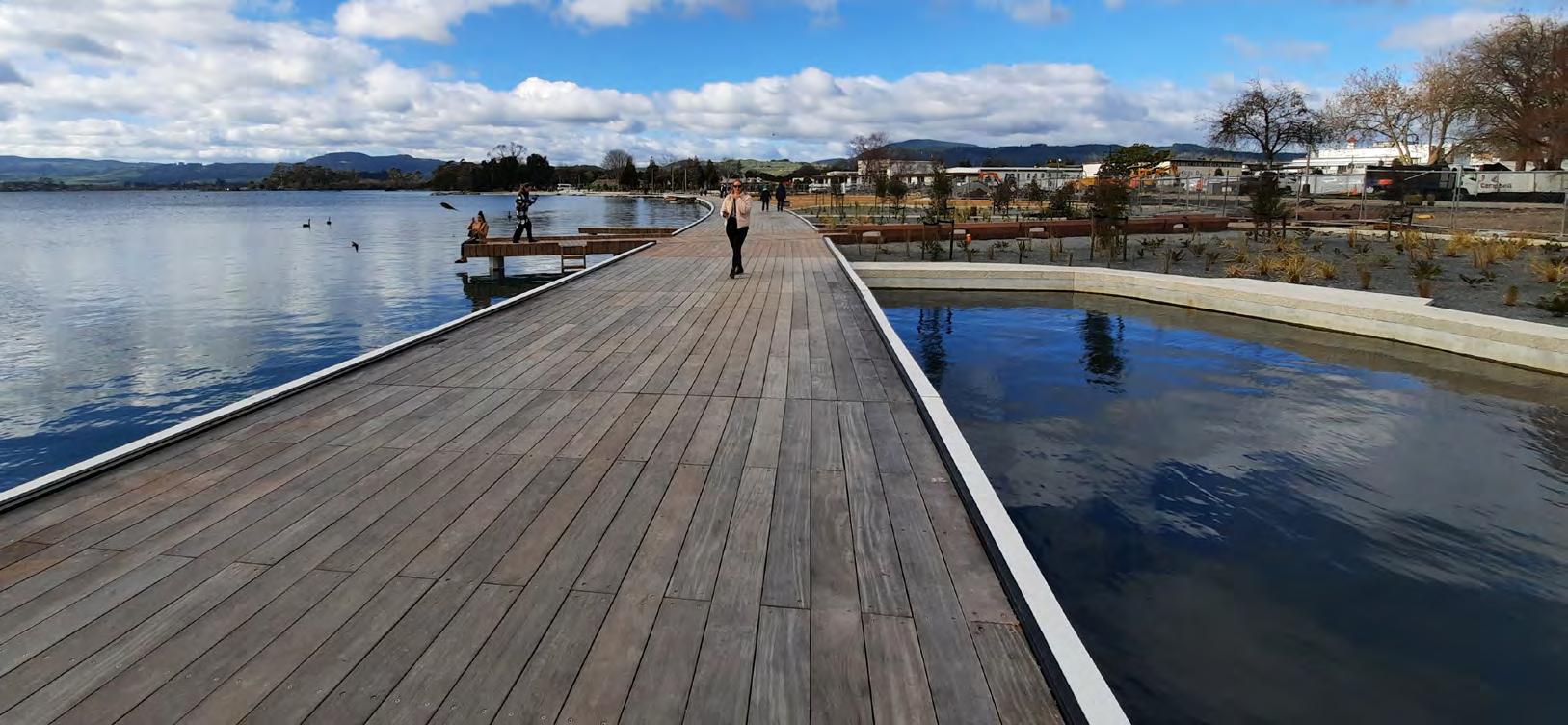
Rotorua has long been known for its strong legacy of resilience and ongoing expression of kaitiakitanga and manaakitanga. Its history tells a unique story of indigenous entrepreneurship and tourism leadership that has continued to evolve across generations.
OBy MARISA BALLE
ver the past year, the Rotorua community has shared with Rotorua Economic Development and Destination Rotorua their challenges and aspirations. And whilst 2020 began on a surge of consumer confidence with the Bay of Plenty recording the highest level of optimism of any New Zealand region, 2021 started on a more sombre note. The data told us that like the rest of New Zealand, our situation was serious and that the solution lies within an all-of-Rotorua approach working in partnership with iwi and alongside local businesses and Central Government.
Fast-forward to where we are now and it would be fair to say our city is well on its way to building back better. From a visitation perspective, we’ve experienced a 30 percent increase in the number of conferences and events compared to 2019, our world-class lakefront redevelopment is nearing completion, and partnerships with iwi and wider stakeholders continue to thrive. It’s also impossible
to ignore that Rotorua is the epicentre of the country’s third-largest export earner – forestry.
In recognition of the role the forestry industry plays in our economy, Te Uru Rākau – NZ Forest Service announced in April this year it would be moving its headquarters from Wellington to Rotorua. With strong ties and working partnerships with Scion, Red Stag Timber, and Toi Ohomai Institute of Technology we’ve strengthened the city’s establishment as an industry leader.
Rotorua’s Wood First initiative recognises the economic, environmental, cultural and social significance of wood within the community. This initiative is about looking at wood as the first material of choice for construction, interior design and living developments within Rotorua, with a long-term goal of taking the Wood First concept to a wider national and international audience.
Awards for new Scion HQ
Scion’s newly built Te Whare Nui o Tuteata recently won international
design accolades, selected as both the 2021 Architizer A+Awards Jury Winner and Popular Choice Winner in the Architecture +Wood category. It then went on receive The Building Award at the 2021 INDE Awards for Indo-Pacific countries, along with an Honourable Mention in The Influencer Award. The INDE Awards saw more than 687 entries from 14 countries in the Indo-Pacific region – no easy feat.
As a destination, we continue to be a preferred choice for New Zealanders and the increase in business activity within the visitor industry reflects this. Our tourism operators are resilient and realistic and have remained steadfast to their values, continuing to be agile as they respond to the ongoing impact of Covid. Just last month, three of our local tourism operators won gold at the Qualmark 100 Per Cent Pure New Zealand Experience Awards held in Christchurch. Kaitiaki Adventures, MDA Experiences and Rotorua Canopy Tours were among 12 New Zealand businesses that won the award. Rotorua Canopy Tours and Rotorua Rafting were also voted Best
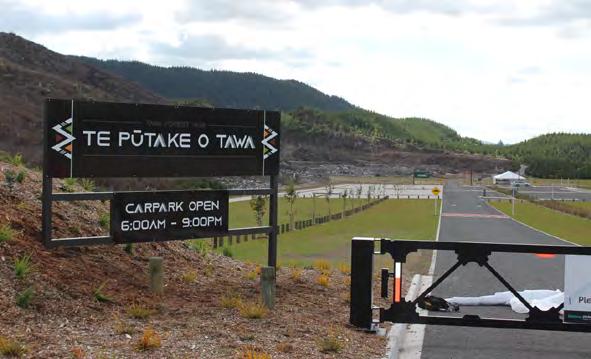
Activities in the World in this year’s Tripadvisor awards.
We’re also seeing a surge in activity in the commercial property space with new businesses being established, and many existing businesses focused on product development. Whakarewarewa Forest is now home to New Zealand’s newest mountain bike hub Te Pūtake o Tawa, situated near Lake Tikitapu, and a new eatery, Eastwood, has opened in the stunning Te Whare Nui o Tuteata at Scion that is also nestled within the forest.
The near-completion of our stunning lakefront, alongside Rotorua Lakes Council’s developing innercity revitalisation plan, means there will be additional commercial opportunities in the CBD that will open up
more opportunities and create a positive flow-on effect for the wider community. Alongside this is the increasing demand for housing which allows developers to realise the potential of investing in our district.
Our place is home to remarkable people who are innately connected to Rotorua’s shared legacy of resilience. Despite the uncertainty a global pandemic brings, we know our communities will continue to adapt and overcome adversity and we need not look far to see the entrepreneurial spirit in action.
• Marisa Balle is Corporate Communications Manager for Rotorua Economic Development and Destination Rotorua.
Established in 1993 with the goal to promote excellence in print in New Zealand, the Pride In Print Awards have been a pinnacle of recognition year after year for the best in visual print communication products produced in New Zealand. They embody a culture of excellence aimed at meeting and exceeding the needs of the customer and continuously pushing boundaries.
It is in the commercial marketplace where Pride In Print delivers its greatest tangible reward. Each sector of the industry is covered, with expert panels of judges analysing every entry. Judging is based on technical excellence in all facets of


In the wake of the recent lockdown, the Government has announced that mandatory record keeping is being introduced for busy places and large gatherings. This means those responsible for businesses and events will need to ensure people keep a record when they visit, either by scanning QR codes with the Covid-19 Tracer App or making a manual record. Mandatory record keeping is currently required at social gatherings including when visiting a marae, at weddings, funerals, tangihanga and faith-based services at Alert Level 2. It will now be a requirement for those businesses and events that are permitted at any Alert Level. Sebastian Hartley, solicitor at Holland Beckett Law, discusses the changes and your obligations.
New Zealand is famous world wide for its Covid-19 stopping lockdowns, but our ability to sustain regional and localised lockdowns, and avoid the full economic impact of shutting down our economy, is only because of our ability to contact trace quickly and effectively.
As the last few days have demonstrated, this ability is of critical importance in the new Delta environment. This is why the Government has now made the decision to formally require contact tracing records to be kept at all alert levels.
This will expand the range of businesses required to contact trace and apply this requirement at all alert levels.
Contact tracing has obvious privacy concerns – it requires people to provide personal information and creates an accessible record of the places they have been.
Making it mandatory has continued to be controversial throughout the pandemic and, probably as a result, the Government has held off on making it a mandatory requirement unless there is an active outbreak.
Under the current rules, at Alert Level 1, businesses’ and event managers’ are only required to display a QR code at or near their main entrance. There has not been a requirement for customers to sign in.
It has only been at Level 2 and above that certain kinds of businesses have been required to keep a record of who has visited – and to monitor their customer’s compliance with that requirement.
Outside of businesses, there have also been record keeping requirements for social gatherings – in particular, gatherings at marae, weddings, funerals, tangihanga and religious
services. Again, this has only applied at Alert Level 2 and above.
The Government has now announced that it will be requiring businesses to do more work to support contact tracing going forward.
This is because in a Delta environment, as the latest outbreak shows, by the time alert levels change, thousands of people may already have been exposed. Being able to quickly and accurately identify those people will be the main tool in avoiding the need to move to Level 4 again in the future.
visitors to aged care and healthcare facilities;
• cinemas, theatres, casinos and concerts;
• customers at massage parlours, beauticians, barbers, hairdressers and exercise facilities; customers at cafes, restaurants, bars and nightclubs;
• indoor public facilities, such as libraries, museums, swimming pools;
• social gatherings including those at marae, weddings, funerals, tangihanga and faith-based services; and
• visitors to courts and tribunals, local and central government
The new changes mean that the contact tracing requirements will extend to a much wider collection of businesses and events. They will also apply even at Level 1. Contact tracing will now be a part of the ‘new normal’.”
The new changes mean that the contact tracing requirements will extend to a much wider collection of businesses and events. They will also apply even at Level 1. Contact tracing will now be a part of the ‘new normal’.
The Government does not usually release the full details of future alert levels until they take effect – draft orders are not being published in advance.
But based on the announcements to date, and the previous rules that have been put in place, it is clear that most businesses will now be captured, including:
agencies, and social services providers with customer service counters such as councils, Ministry of Social Development offices. It is not clear whether this will apply to large-volume businesses like supermarkets and petrol stations that are currently open – but which are not required to contact trace customers at present.
It is likely that this will also be combined with a requirement for customers to sign in themselves, although the Government has made clear that the emphasis on enforcement will be on businesses not individuals. However, this may change over

time as people get more used to the requirement of scanning in wherever they go. These new restrictions will be in force in each region about seven days after it enters Level 3. This will give businesses a week’s grace to get up to speed with the new measures. However, we are recommending that businesses start immediately, so they can iron out any difficulties with their systems.
Once a new order is put in place to cover the contact tracing requirements, the same penalties will apply under the Covid-19 Public Health Response Act 2020, which provides the authority for the Government’s actions.
Under this Act there are effectively three levels of penalty that can be applied:
• An infringement notice (like a speeding ticket) for $300 for any breach
• An infringement offence – which is like an infringement notice but must go through the Court and can include a fine of up to $1000; and
• A conviction offence – for intentionally breaching the order –which carries a conviction and a maximum penalty of six months imprisonment or a fine of up to $4000.
So far, the police have been cautious in using their formal powers and have only charged people who are either committing quite serious offending or who have repeatedly failed to comply.
We expect this to continue – people who are caught out by accident in the early days will likely receive warning or infringement notices; people who refuse to comply and continue to act in breach may be charged.
It is important to note that Courts take these offences seriously. During the March 2020 lockdown, many people who breached received short sentences in prison: deliberate flouting of the law carries a very real risk of similar treatment. For many people the risk of a criminal conviction will also be a significant deterrent.
While businesses will now be required to comply with these obligations, it is important that they also take into account their obligations under the Privacy Act 2020 when recording information. Key obligations include:
• Only gathering information that is necessary;
• Only using information for the purpose for which it was gathered; and
• Destroying information when it is no longer needed.
Contact tracing information should be kept separate and destroyed after a matter of weeks. It should not be used for other purposes (like client data bases) without specific permission. As the information is highly personal, it must also be stored carefully to avoid anyone accessing it.
The risks of getting things wrong in terms of privacy are serious with compensation for breaches often exceeding $10,000.
With the frequent changes to the rules, it is important to have people on your side who understand the requirements and can help you ensure your business complies with all of the requirements.
Our team are more than happy to discuss your situation and help you better understand your rights, obligations, and options.
• Content supplied by Holland Beckett Law
An industry-leading Tauranga start up has crowned off a major earnings surge with a capital injection of $17 million from a New York venture capital and equity firm.
By RICHARD RENNIE
LawVu, a company developing and selling software for in-house legal teams has welcomed the $17 million, which includes support from Australian venture capital firm AirTree Ventures.
Sam Kidd, LawVu co-founder, welcomed the significant capital injection at a time when corporates were intensifying efforts to improve their counsels’ technology.
“In house legal teams perform a critical function inside every corporation. However, you will often find the only ‘tech’ they have is email and word documents.
“Legal teams are becoming a bottleneck, as the rest of the business leverages off technology and speeds up.”
The firm was established by Kidd and Tim Boyne in 2015, stemming in part from Boyne’s employment with a leading city firm, and his frustration at the delays in compiling monthly reports for big company clients.
Combined talents
The men combined talents, with Boyne’s experience in law IT systems and Kidd’s ability project managing software development pushing the company along quickly.
LawVu combines a range of software tools based around document creation, record keeping and time management under one umbrella, replacing the Post-it notes Kidd says are often employed by teams to keep track of jobs.
The platform allows teams to manage all their matters, contracts, documents, e-billing, outsourced work, and reporting from one cloud-based, secure, and connected platform, with a connected third-party tools critical to a high-performing in-house function.
The initial big break for the company came with Telstra adopting the software suite, and other large Australian corporates and public entities quickly following. Large clients in New Zealand include Zespri, Fonterra, Sky, and Harcourts. The company’s technology is now in 30 countries.
LawVu is considered the leader in this space amongst many of the most tech savvy in-house legal teams in the world.”
– James Cameron
James Cameron, a partner in AirTree Ventures, said there was a big push globally to get in-house legal teams up to speed with technology, and improve their efficiency in the process.
“LawVu is considered the leader in
this space amongst many of the most tech savvy in-house legal teams in the world. It is also fantastic to be investing alongside world-class global investors like Insight to help continue to grow the business in its biggest markets in the US and Europe.”
He said there was significant demand from global investors to invest in fast-growing Australian and New Zealand tech businesses.
The injection comes after the company earlier secured $2.5 million of funding through convertible notes, supported by NZ Growth Capital Partners.
Funding has also come from local investor Craig Wearne who liked the idea from the get-go.
The latest investment enables the company to continue to optimise in-house legal team performance and increase their engagement with the broader business.
Are you thinking of exportin’ to Australia? Got your IP rights in order? Not yet? Well, don’t leave it too late because ‘she’ might not be right if you do.
While Australia’s IP laws, rules and processes are for the most part identical or very similar to New Zealand, there are key differences which exporters should be aware of, and seek advice on, when planning the growth of their business.
This article focuses on the areas of Australia IP law that I most commonly advise aspiring exporters on in my legal practice: trademarks and domain names, and design and copyright.
Trademarks and domain names
As in New Zealand, rights in trademarks (typically brand names and logos) in Australia are acquired through use and/ or registration.
Registered rights are best, as they give exporters rights across Australia as a whole –unlike use-based rights, which are usually geographically limited in scope; that is, they are limited to the city/state in which you sell goods are sold.
Registered rights in brand names are also best for two reasons: first, because your
brand name will be protected regardless of how it appears in graphic form (including a logo); and, second, because, as I talk about shortly, they enable exporters to register a com.au domain name for their Australian business (if they want to register such a domain name).
Some exporters may not be able to register their brand names as word marks because they descriptive or generic, in which case obtaining registration for a logo mark is better than no registration at all.
Other exporters may not be able to register their brand names because someone else is already using or has registered an identical or similar trade mark in Australia.
If you find yourself in that boat, you should investigate what your options are before making any decisions.
Registered trademark rights are particularly important in Australia if aspiring exporters are considering operating a designated Australia website under a com.au or net.au domain name.
This is because to register a com.au or net.au domain
name, there are certain eligibility criteria under the ‘.au Domain Administration Rules: Licensing’ (‘the Rules’) that must be met:
• Firstly, the person applying to register a com.au or net. au domain name must be a commercial entity;
• Secondly, the domain name applied for must be a match of, for example: the person’s company, business, statutory or personal name; an acronym of the person’s company, business, statutory or personal name; a match of the person’s Australian Trade Mark (noting that “Australian Trademark” means either a pending trade mark application or a registered trade mark that appears on IP Australia’s trade mark database); or a match or synonym of the name of a service that the person provides or goods that the person sells (whether retail or wholesale). In practical terms, the simplest way for an aspiring exporter to be eligible to register a com.au or net.au domain name is to have filed (and had

> BY BEN CAIN
Ben Cain is a Senior Associate at James & Wells and a Resolution Institute-accredited mediator. He can be contacted at 07 928 4470 (Tauranga), 07 957 5660 (Hamilton), and benc@jaws.co.nz.
published on IP Australia’s database) a trademark application for their company name or their service or product brand name.
As the criteria above indicate, however, the desired domain name must be an exact match of the words which are the subject of the Australian Trademark application or registration (noting that the definition of ‘match’ in the Rules excludes commercial status identifiers like “Limited”, punctuation marks, articles such as “a”, “the”, “and”, “or” and “of”, and the symbol “&”).
Designs and copyright
A fundamental difference between New Zealand and Australia IP law is the lack of copyright protection for “industrially applied” product designs in Australia. In New Zealand, owners of CAD drawings used to manufacture physical products for sale or hire, for example,
I commonly get asked by business owners, purchasers and professionals “what is a business worth” and I usually respond with “it depends”.
I
t depends on a number of factors that should be taken into consideration when establishing a business value including industry, location, owners input, staffing and supply chains to name a few.
However, the most important factor is the “Future Maintainable Earnings” (FME) of the business and whether that is transferable to a new owner.
Wayne Lonergan puts it well in his book (The Valuation of Businesses, Shares and Other Equity), states: “Too many FME-based val-
uations are flawed in that they automatically employ historical profits as a proxy for FME, without undertaking sufficient critical examination of the past performance and likely future events. An understanding of the future profits of a business is essential for an accurate valuation, yet is omitted when historical profits are used in isolation”.
The key question for me when assessing a business is to understand the environment they are currently operating in and the impact this has in establishing the FME.
As we well know, the business environment for a lot of businesses has changed dramatically over the past 18 months due to the pandemic, supply chains and a tightening labour market.
To complete a valuation appraisal we effectively undertake a full due diligence on the business examining the owners’ involvement and skills, staff structure, lease arrangements, customer breakdown and industry sector. Once we have completed an analysis of this information, and established
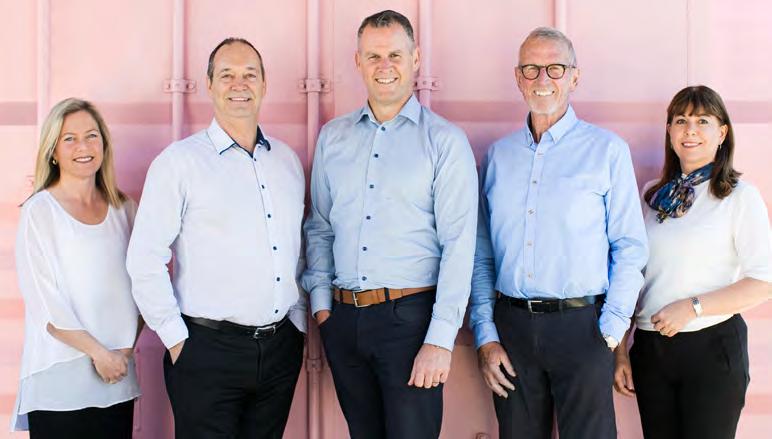

the “Future Maintainable Earnings” of the business we are then in a position to compare the subject business with sales data from other similar businesses that have been sold. This comparative data coupled with our own business examination essentially forms the basis for establishing the valuation range.
At Tabak’s we are engaged to complete apprais-
enjoy copyright protection for 16 years from the date the 51st product is manufactured from those drawings.
Not so in Australia. In Australia, exporters of such products do not, except in certain limited circumstances, enjoy copyright protection in their CAD drawings. Exporters must either rely on registered design rights or consumer awareness of their product’s appearance in Australia to prevent or stop copying.
Registered design rights protect the shape and configuration, pattern or ornamentation of or on physical article – in other words, the item’s appearance.
Design rights do not protect how things work (which is the remit of patents), the materials used in products, the size of a product, or designs with no physical form, such as computer graphics.
Registered design rights are preferrable to reliance on consumer awareness of a prod-
uct’s appearance because they do not require public use of a product design in order for any rights in the design to be enforceable.
Quite the opposite, in fact. To be registered in Australia, a design must be new and distinctive, where ‘distinctive’ means not identical or substantially similar to a design previously publicly used in Australia or published in a document in or outside Australia.
Due to this requirement, if Australia features in an aspiring exporter’s plans it is crucial the exporter seek registered design protection as early as possible – potentially months if not years before any product is actually shipped to Australia.
Finally, I note that this article is for general information purposes only and is not intended to be a substitute for legal advice. If you are in need of advice, please contact your IP specialist.
> BY PAUL BRLJEVICH
Director at TABAK Business Sales. Paul can be reached on 027 693 4079 or paulb@tabak.co.nz
als for a variety of reasons including to establish a market value for sale purposes, marital and business ownership disputes and management buy outs. In all cases we work closely with accountants and business advisors to provide a realistic market value that we are prepared to stand behind.
Tabak brokers are in the fortunate position of being able to have our appraisals

peer reviewed by members of our wider Tabak NZ team which includes Chartered Accountants, MBA Graduates, Business and Management Degree Graduates, holders of the Advanced Business Valuation Diploma plus other brokers who have been involved in business ownership. We all combine to have many years of experience in appraising, negotiating and selling businesses.

Tauranga City Council commissioners are calling for community input to include in feedback to the Government on its three waters reform proposal.
Commission Chair Anne Tolley says the reform proposal is complex and much of the detail still has to be finalised, but potentially, it does offer an effective model for delivering high quality and affordable drinking water, wastewater and stormwater services.
“Research indicates that over the next three decades, huge investment will be required to ensure all New Zealand communities continue to have the safe, effective and sustainable water, wastewater and stormwater services they need,” she says.
“The fact is that the bar is continually being raised as new health and environmental standards evolve and communities grow. The reform pro-
posal aims to get ahead of that and put a structure in place that can provide the investment and service quality required to futureproof three waters services.”
Key facets of the Government’s reform proposal
• There will be four new, regional water service entities across New Zealand. Tauranga is in ‘Entity B’, which includes the Bay of Plenty, Waikato and Taranaki regions.
• These entities will take over the management of water assets, debt and income streams from councils. Councils will jointly own the water entities on behalf
of their communities.
• Councils and iwi/Māori will contribute to the objectives and priorities of these entities, through a proposed 50:50 governance model that honours the Treaty of Waitangi.
• The entities will be held to account by the drinking water regulator, Taumata Arowai, to ensure public health remains paramount.
• The new entities will be required to consult with communities.
• A funding package has been offered to ensure no council is financially “worse off” as a result of the reform.
• An additional future funding package has been offered to each council to ensure the reform leaves
all communities “better off”. Based on a population/deprivation/land area formula, Tauranga would receive $48.5 million, with the bulk of the funding becoming available in 2024.
A key building block of the reform will be a partnership with tangata whenua, in accordance with the principles of the Treaty of Waitangi. The reform also aims to deliver the outcomes of Te Mana o te Wai, a set of principles co-designed with iwi/Māori to lift the water quality of our streams, rivers and lakes.
Anne says that if the three waters service delivery stays as it is – managed by 67 separate councils – future service quality across the country will

remain variable and the level of investment required will mean services will become unaffordable for many people.
“What’s proposed is a significant change, but this does provide an opportunity to co-design a delivery model that will work for all New Zealanders. We’re keen to gauge the community’s views on what that model should look like and what safeguards are required to protect the community’s interests,” she adds. Issues identified by the Commission for raising with central Government include:
Ensuring that our communities have an opportunity to provide local input into the reform process
• Protecting our water assets against privatisation
• Clarifying how we manage our water assets and staff during a transition period
• Ensuring that Tauranga’s growth needs will be met in a timely fashion, and given appropriate consideration within Entity B’s priorities
• The impact of the reforms on stormwater, as the focus has mainly been on drinking water and wastewater. The Council has until the end of September to consider the potential impact of the reform, identify areas of concern and advocate for the best community outcomes. As part of that process, business leaders can provide feedback on anything they want commissioners to raise with the Government by going to: www.tauranga. govt.nz/three-waters-reform
Sickness isn’t the same anymore. Covid-19 has made it all the more important for people to stay home when they’re unwell.

> BY CRAIG HUDSON
arlier this year, Parliament passed the Holidays (Increasing Sick Leave)
Amendment Bill to increase the minimum employee sick leave entitlement from five days to 10 days per year.
While the minimum amount of paid sick days has doubled, the maximum amount of sick leave that can be taken by an employee remains at 20 days.
It’s important to reframe how we think about employees taking sick leave.
Not only do we need to prioritise keeping germs away from the workforce, but we need to consider how sick leave impacts your employees productivity levels and their overall wellbeing.
In fact, making a concerted effort to empower your employees to look after their health and wellbeing has the potential to increase the overall productivity and profitability of your business.
So, if an employee is starting to feel unwell, in any capacity, it’s better for the employee and your business that they take time to recover instead of coming into work when they’re not feeling 100%.
But sometimes workplace culture can get in the way of these conversations. This is where establishing an environment where it’s okay to ask for help is beneficial. After all, healthier, happier workers are more productive workers, achieving more with their time and producing work to a higher standard. According to the NZIER, poor wellbeing affects decision making and productivity for an average of 13 weeks.
Imagine the difference in productivity if workplaces put more emphasis on creating a culture where it’s okay to ask for help.
All workplaces play a central role in building people’s resilience and positive wellbeing, so they can better cope with setbacks, take advantage of opportunities and be productive, contributing members of families, communities and workplaces.
This starts with communicating with your staff and fostering a supportive culture where employees feel comfortable to take leave when they need to.
For example, take time to get to know your team, what makes them tick, and how they manifest stress.
Fostering these relationships goes a long way to creating an open workplace culture where people feel safe and empowered to have discussions about what they need –from sick days and schedule

Recognising the signs of employees dealing with poor health or wellbeing means being able to proactively support them to manage their workload at work or while they take time off.”
flexibility, through to taking some proper leave to recharge their batteries. We spend so much time at work, why not make the most of it and reinforce a healthy culture of camaraderie between your employees? Investing in fostering a good culture doesn’t have to cost a lot of time or money.
One thing to consider is how you and your employees talk about sick leave, and whether there’s a benefit in examining what this entails.
A shift happening in organisations across the world at the moment is reframing this as “wellbeing leave” to encompass everything people might feel compelled to take leave for.
Something as simple as changing how we refer to leave can open up how people use this, allowing them to take leave for things that are important to them – or simply take a break for their own mental wellbeing.
Recognising the signs of employees dealing with poor health or wellbeing means being able to proactively support them to manage their workload at work or while they take time off. And creating a culture where people are empowered to make the right decisions for their own health is essential, whether that’s taking sick leave or spending time to address other wellbeing issues.
The Forest Owners Association said in a statement that the recent Beef+Lamb-commissioned survey on forest planting rates is nowhere near robust nor detailed enough to draw a conclusion that the government should impose controls over the rate of forest planting.
Forest Owners Association
President Phil Taylor said the Beef+Lamb report was a worthy contribution to the land use debate, but that it raised more questions than it answered.
“Government data is contradicting the report,” said Taylor. “Official figures clearly point to a decline in the area of the exotic plantation forest estate, and so new planting is not keeping pace with the land area going out of forestry.”
The plantation forest estate had shrunk by 162,000 ha in the past 18 years, mostly to dairy farms, said Taylor, who noted that there had always been changing land use.
“Our concern on current figures, would be that the Climate Change Commission’s reliance on an expansion of the exotic forest area by another 380,000 hectares by 2035, to meet the 2050 greenhouse gas target, is going to fall well short.
“On top of that, the Climate Change Commission anticipates there will need to be more use made of wood in construction, and its extensive utilisation in biofuels to replace fossil fuel.”
Risk of not meeting carbon targets
Taylor said that meant any government restrictions on afforestation would risk New
Zealand not meeting its carbon targets.
“By the time that shortfall becomes clear it will be too late to fix it,” said Taylor.
The National Exotic Forest Description, which is published by the Ministry for Primary Industries, recorded a reduction in the net stocked area in the year to April 2020 of 31,347 ha, after allowing for 19,000 ha of new afforestation.
Forestry stacks up well as a land use
“And that makes sense for farmers,” said West. “The recent PwC report was clear that forestry stacked up very well as a land use and so forestry benefits the economies of local communities.
“There is between 7.5 and 10.4 million hectares of hill country farm land, and if a
There is between 7.5 and 10.4 million hectares of hill country farm land, and if a conversion of a mere 380,000 ha is a threat, then the meat and wool industries has more serious issues to deal with than just a few profitable trees to worry about.” – Graham West
The President of the Farm Forestry Association, Graham West, said farmers should be free to continue to make economic decisions on whether they want to use their own land to plant trees and on what land classes.
A recent Ministry for the Environment study has shown that there is currently 313,000 ha of plantation forests on farmland.
conversion of a mere 380,000 ha is a threat, then the meat and wool industries has more serious issues to deal with than just a few profitable trees to worry about.”
West said the report was actually positive about the integrated use of trees on farms and that land sales to forestry are giving better capital gain, which allows movement up the farming ladder or retirement.

BakerAg, the report’s author, stated: ‘If farmers already have experience with trees and forestry, or are confident of the support available in what may not be core business to date, then indicators are this will provide further confidence to consider investing in forestry as part of the land-use mix.”
Taylor said Beef+Lamb automatically assumed that farming would always be a better and more productive land use than forestry.
“On the tougher hill country, Beef+Lamb are now demanding that even if livestock can barely survive on that land, then tree planting should still be restricted,” said Taylor.”
Very little known
According to Taylor, the report showed that very little was known about the extent of carbon-only forest planting in recent times.
“The Beef+Lamb report estimates this non-harvest forest planting is about 30 percent of the total planting. But nobody has any real idea at the moment. If this carbon planting is on land which could be productive for timber or livestock then we would have concerns that the land should be used better.”
“After all, there’s at least a million ha of land in New Zealand, which is too remote or erosion prone for farming or for production forestry and so is ideal to use for locking up
carbon, but not useful for anything else.”
Taylor said it was important to realise that while forestry is hugely important in sequestering carbon produced by industrial emitters over the next three decades, trees do not offer a continuing long-term answer to greenhouse gas emissions through offsetting.
“We have no issues with either Beef+Lamb or the Climate Change Commission in their same view that the only effective long-term response to the threat of climate change is to reduce those source emissions, wherever they come from. Farmers who are expected to produce this extra value strongly demonstrated against regulations recently. They don’t need more restrictions.”
Despite the uncertainties resulting from Covid-19 lockdowns in late August,
commitment to the Bay of Plenty

Alex Russell
Apricity Finance recently welcomed Alex Russell to the team as Business Development Associate. With a background in the insurance industry, Alex prides himself on developing and maintaining strong relationships and consistently delivering a
high level of customer service. Passionate about exercise and learning new things – Alex is approachable and happy to discuss business cash flow challenges. He can be contacted via alex@apricityfinance.com or 021 719 037.
Kate Romey is heading up New Zealand operations of the trans-Tasman construction and engineering staffing recruiter, Marble Kate is based out of Tauranga and recruiting across Bay of Plenty, Waikato and Auckland regions. Her key focus is white collar appointments within residential, commercial and civil construction.

Expansion across New Zealand is on the horizon, including other regions and staffing offerings. Kate holds two years of specialist construction recruitment experience in Sydney and New Zealand. She is excited about opportunities that exist within the ever-changing construction and design industries and bringing her knack and passion for matching talent with great organisations.

Kaydi O’Conner has joined Page Macrae Engineering as Marketing Specialist. Kaydi comes to Page Macrae from her previous role at Priority One which enabled a good insight into local Bay of Plenty industry.
Given Kaydi’s sporting background in representative canoe slalom and her passion for storytelling, she is well placed to drive Page Macrae’s new market and products marketing strategies.
Sustainability is becoming a more integrated consideration for all industries – Kaydi is very passionate in this area, with a totally holistic approach to not only our environment, but also our people and communities.
Her involvement in growing tomorrow’s minds with the likes of the Young Innovators program, which

$30.8m net profit before tax – up 77% on six months to 30 June 2020.
Listed New Zealand produce company Seeka Limited, with operations in New Zealand and Australia, is pleased to report its unaudited interim results for the six months ended 30 June 2021.
“Seeka delivered outstanding customer service and excellent financial results to shareholders in the first six months of 2021,” says Seeka chief executive Michael Franks.
“Strong demand for our services contributed to record Group revenues of $224m in the sixmonth period; up 26% on June 2020. Importantly, we’ve delivered on our strategy to improve earnings, posting $30.8m net profit before tax for the period, up 77% on the pcp.
“Seeka continues to invest in our kiwifruit business, acquiring Ōpōtiki Packing and Cool Storage Limited (OPAC) in May. OPAC is an eight-million-tray kiwifruit operation that expands our service delivery to the Ōpōtiki, East Cape and Gisborne regions. OPAC is now integrated, synergy savings on target, and the business is set to make a full-year financial contribution in 2022.
“We have also made a significant investment into agritech, taking a cornerstone stake in the digital startup Fruitometry. See-


ka’s investment will accelerate the development of smart orchard scanning technology that will help lift orchard production and realise supply chain efficiencies.
“Our New Zealand kiwifruit business is in a strong growth phase, and Seeka is investing $20m in capacity builds for harvest 2022, including a new automated packline and high- efficiency coolstores near Te Puke. These new facilities will improve labour use while providing us with post-harvest capacity through to 2024.
“Sustainability is a major focus and we are implementing strategies to minimise our environmental footprint. Our 2019 carbon footprint has been independently verified, and we’re defining performance baselines so we can set reduction targets and measure efficiency gains. Seeka is working to be an industry leader on reporting the impact of climate change and we are making real progress to reduce our emissions,” says Franks.
Hundreds of Bay locals now own a slice of their own backyard.
Over 2000 new investors, including many Bay of Plenty residents, have jumped at the chance to own a share of Bethlehem Town Centre.
Unlisted commercial property funds manager PMG Property Funds Management Limited (PMG) has now closed its latest offer in its PMG Generation Fund. Funds raised will help buy the high-profile Bethlehem Town Centre for $107.6m* alongside an industrial property at 11-13 Gough Street in Seaview, Wellington. Conservative bank borrowings will fund the remaining purchase price.
PMG Chief Executive Officer Scott McKenzie says it’s a privilege to be the new owner and custodian of Bethlehem Town Centre as it’s a vital community hub. “We are looking forward to enhancing the value of Bethlehem Town Centre and further building its reputation as the shopping destination of choice in this region.”
McKenzie says the ongoing low interest rate environment, coupled with headwinds in residential property investment, is generating a high level of interest in commercial property from a wide range of individuals.
In a first, PMG partnered with online investment platform Sharesies and InvestNow to bring this offer to market, which has resulted in over 1,850 new investors joining through these investment platforms.
“At PMG, we’re passionate about creating value and security for people in property, helping New Zealanders achieve financial freedom. We have great respect for the innovative work Sharesies have done to simplify the investment landscape and build financial literacy and we’re delighted to expand our reach and partner with them as part of this latest offer to market.
“Investment in unlisted commercial real estate is sometimes seen as out of reach for many New Zealanders. Through Sharesies and InvestNow we are able to help people overcome some of those barriers to invest in commercial property and make it easier for everyday Kiwis to participate.”
The new acquisitions bring the total portfolio value of PMG’s Generation Fund to an estimated $166m*. The Fund comprises five quality commercial properties located within main metropolitan centres across New Zealand and is underpinned by notable tenants, some of which are classed as essential services and provide further confidence around the Fund’s income resilience for investors.
McKenzie believes the strong uptake from both new and existing investors – in one of New Zealand’s largest directly-held and unlisted commercial property funds – is a reflection of the track record PMG
and its funds have demonstrated over time.
“We are extremely pleased with the number of investors who have come on board and the feedback we have had about the quality of our offer and the acquisition properties, including the spread of income risk via multiple tenants, in various industries and the offer of a regular cashflow at an attractive rate.”
PMG’s Chairman of the Board Denis McMahon is impressed by the strong response to the offer, which had an accessible minimum investment threshold of 1,000 units ($1,090).
“When we launched PMG Generation Fund in 2020, the aim was to help more New Zealanders gain access to the benefits of investing in commercial property, providing regular income and the opportunity for good capital growth on their investment. This latest offer has certainly achieved this.”
Since its inception, PMG Generation Fund has delivered a gross cash distribution return of 5.80 cents per unit* to its original investors and has seen a significant increase in the value of its underlying property assets. With a forecast gross cash return of 5.5% p.a.**, paid monthly, this offer delivers an attractive passive income so investors can enjoy the lifestyle they love, well into the future.

Us kiwis have always prided ourselves on being a DIY-capable, ‘get it done’ “leave it to me” kind of people. And while this is without doubt an admirable quality to possess it can sometimes be taken too far when it comes to running businesses. I have seen this lead to the downfall of many businesses, especially during phases of growth where the business owner refuses to let go of some of the control.
Let’s put this into the context of the current building boom in the Bay of Plenty with a fictional, but familiar example: Bob is a plumber who has gone out on his own after leaving a large firm. He picks up a few builders that he works for and because of his good quality of work he starts to get busy. Two months after striking out on his own, Bob is spending 30 hours a week doing plumbing and travelling to jobs and 15 hours a week doing quotes, invoicing and general administration.
A few more clients come on board and at month three, Bob is doing 40 hours of plumbing and 17 hours a week of admin.
At month four, Bobs’ business is still growing and he takes on another plumber to “lessen” the stress.
But Bob insists on still doing all of the administration, including invoicing, ordering materials and quoting, which at this point is over 25 hours a week as he now must schedule all of his work and that of his staff member as well as doing his 30 hours a week on the tools.
At month five, Bob is pretty much at maximum capacity and should an incident happen, such as a day-long disputes tribunal hearing with a disgruntled client, a Worksafe investigation, or his staff member being sick for a day, then the whole house of cards comes tumbling down. A symptom of this is often shown in the debtors’ ledger of businesses. Where the owner operator is the one doing the work and doing all of the admin, often the last thing

>
BY NICK KERR
Nick Kerr is a Business Advisor at NJK Advisory Ltd. He is also director of International Private Investigations Ltd. Nick can be reached at nick@nzipi.com
on the long list of tasks is the overdue accounts.
I have seen owner operator-run trades businesses write off thousands of dollars of accumulated overdue accounts a year because they simply do not have the time to chase them up, but they still refuse to contract an administrator as they do not want to relinquish control or don’t feel that the administrator will do as good a job as they would. My answer to this assertion to them is, would you hire a painter to fix your car? Would you hire a Vet to paint your house?
As silly as this seems, it is
true that if you specialise in a task (like administration) and do it for long enough you should be better at it than an overworked and stressed out
“other subject matter expert” person who is trying to juggle that activity with 10 others.
I have interviewed multiple owners of small liquidated trades businesses and the most common admission of fault they make is “I tried to do everything myself”.
The first thing that they do when starting a new business is hire someone to do the tasks that they are not expert in.
Like some NZ city coun-
cils, small businesses often wait for growth to become untenable before infrastructure is addressed. There are business growth experts and outsourced admin businesses out there that specialise in taking the stress in this area away from business owners, you just have to ask. My own investigations company brought on an admin expert six years ago and it transformed our business into an industry-leading profitable entity that is fun to work in rather than a struggling stressful mess. Just a thought.
Nearly 600 respondents participated in the inaugural EMA Workplace Wellbeing Survey 2021 which was delivered in partnership with nib New Zealand.
The results highlighted challenges, and the connections between wellbeing and engagement, retention and productivity for businesses. Small business choices have the most significant everyday impact on your people – and ignoring them could be a huge risk to your business.
While 84% of survey respondents strongly agreed that staff wellbeing initiatives contributed to the retention of high performing employees, the most common methods of measuring staff wellbeing relate to turnover and retention levels (65%), absentee rates (63%) and exit interviews (48%).
Survey findings indicated that one in six companies do nothing to track and measure wellbeing, and of those, 33% were small businesses with less than 15 employees. On a positive note, small businesses were seen as particularly good at responding to requests for flexible hours, with 62% of respondents from organisations with less than 15 staff saying their employers did so ‘really well’, compared with 43% overall.
nib highlighted that strong communication and support during the height of the pandemic saw 55% of respondents report improved job satisfaction over that time, but that worryingly these levels have since dropped.
In addition, 32% of respondents were concerned about the health of their family (up 10% from pre-pandemic levels), one in four had concerns about their own health (up 11%), closely followed by 23% being concerned for the mental health and wellbeing of their family (up 6%).
Given that one-in-three employee respondents also believed their employer could be more proactive at prioritising, adapting and implementing wellbeing strategies, it’s time for businesses to do something different.
When viewed in the context of productivity, culture and employee appreciation, it’s the extras in the office environment that are proving their worth in today’s marketplace.
Bayleys’ global real estate partner
Knight Frank recently released its (Y) OUR SPACE report, which drew on responses from almost 400 international businesses. It found that within the next three years, 47 percent of firms will seek to improve the quality of the real estate they occupy, with 46 percent looking to improve the amenities available to employees within the workplace.
Steve Rendall, Bayleys national director office leasing, said amenity-rich offices were making their mark pre-pandemic as companies sought to differentiate themselves in the market and take their corporate culture up a notch.
“However, after the events of 2020 and the enforced work-fromhome experiment, the office of today needs to offer tangible value to employees who have demonstrated that it is possible to work remotely.
“Employers need to look beyond merely providing desk space and a staffroom, and not only give people reasons to come back to the office, but give them an environment that supports them on many levels.
“Innovative spaces that bolster the physical and mental wellbeing of staff like collaborative lounges, breakout spaces, gym facilities –even on-site childcare – are making their way up the list of amenities that are now seen as global best practice.”

Knight Frank’s (Y)OUR SPACE report found that the top four amenities identified by at least 45 percent of respondents are all well-being related. These include healthy food and beverage offerings, the provision of gym and changing facilities, along with other amenities that support mental wellbeing.
Think dedicated rooftop gardens, meditation spaces, sleep pods, yoga classes and biophilia-related amenity for that feelgood factor. This could include plenty of natural light, loads of
fresh air, green spaces, the use of natural materials and water features.
Rendall said that in a post-lockdown world, people want to feel valued and appreciated, and there is also an innate need for social connection.
“Balancing a company’s productivity goals against the well-being of its staff has been thrown into sharp focus,” he said.
“One of the world’s biggest developers, Lendlease, claims the pandemic may have shifted the dial with the physical location of
an office now having less importance than the connectivity, amenity and sense of place it offers.”
Within mixed-use precincts, office workplaces are often integrated with retail outlets, hospitality/food and beverage options and fitness studios and this convenience factor is proving useful in staff recruitment and retention. Office workers can easily tick multiple life admin and recreational tasks off the list during their working day, meaning that once they get home, they can relax.
Having onsite childcare could facilitate even greater efficiencies and while many mixed-use precincts include childcare centres, globally, this is being taken further within office tower developments. In the United States, a proposed multi-billion Child Care Growth and Innovation Fund would create an expanded tax credit to encourage companies to build onsite childcare facilities which, with the widespread uptake of more flexible work models, may encourage parents to return to the office.
Rendall said whether New Zealand goes this far remains to be seen.
“But there is no question that forward-thinking developers and landlords will continue to value the availability of high-quality childcare solutions when positioning their office buildings in the market.”
www.bayleys.co.nz/workplace/ office/insights

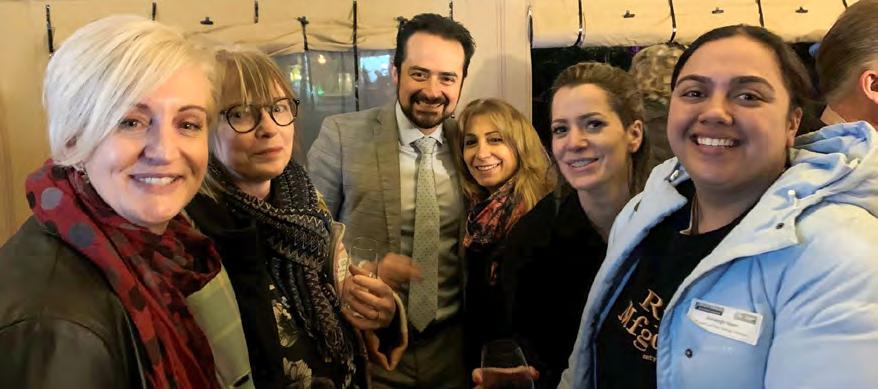
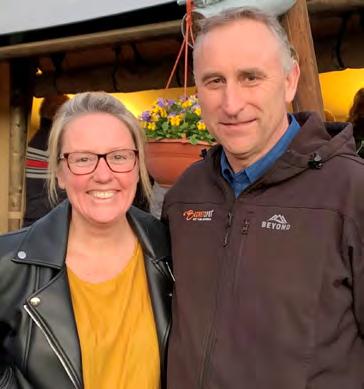
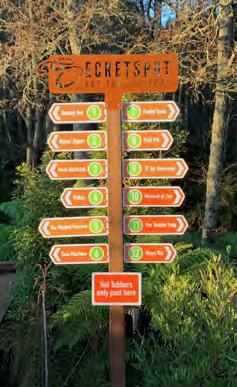

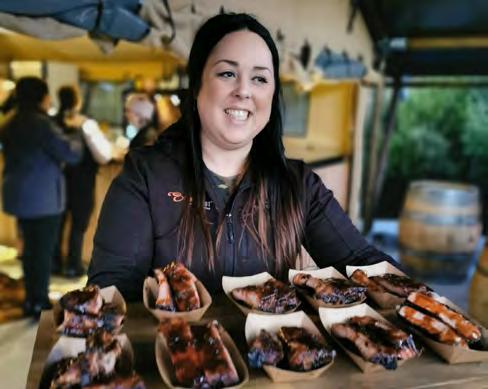



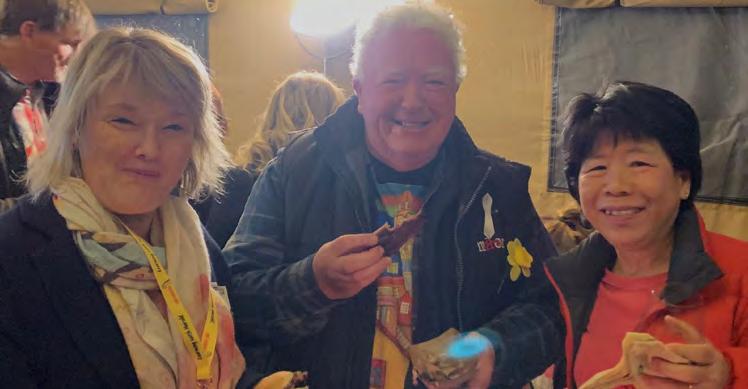
1 4 7 12 6 8 9 10 2 3 5 13 11
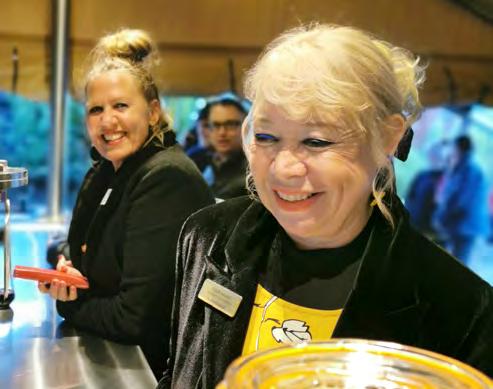



Musings on luxury and leisure, post annus horribilis
I’m going to describe my limited understanding of a process that I have grown up admiring – we pour in petrol, and when we turn a key a battery causes a starter motor to “start” an engine.
Sparks are created which cause explosions (loud) and these explosions cause pistons to move, thus driving power to wheels (via lots of other bits).
And here’s the really cool kicker: the dirty bits of leftover exploded stuff are then expelled out a pipe into the atmosphere, but the pipe has a part which ‘muffles’ much of the noise from the explosions (less loud) – nice touch.
Now don’t get me wrong, I love the noise, and the vibration, and the smell, and the whole vibe, so yes, I guess I am a petrolhead.
But, it’s 2021 and we live in a world with no plastic bags, surrounded by electric scooters, battery power tools, voice-activated mobile devices, wifi-enabled, satellite directed, un-manned and un-womaned autonomous everything.
My carbon fibre running shoes give me a remarkable four percent efficiency boost, my raincoat is nuclear-fallout resistant, my eyes are lasered, my teeth are veneered, my fat is surgically removed and my
dog is micro-chipped.
I mean, my mechanic doesn’t even use a spanner, he just plugs in his laptop to my dashboard and hey presto, my car is fixed.
So, is it just me, or does the concept of us still using the petrol explosion polluting engine method to move around our neighbourhoods so loudly while expelling the dirty exploded bits into the air seem … well … archaic?
This is not good vs evil
No, don’t stop reading. This is not a diatribe on good versus evil; I’m not being paid by anyone (yeah, but that’s another story) to say electric is good and petrol is bad.
In fact, I’m one of those people saying, “It’s all very well for you to slag off air travel, but I’m not swimming to Oz, and neither, I suggest ‘Mr Greeny Boy’, are you!” (OK, traveling to Australia is a bit theoretical right now, but you get the point).
But I have been thinking about the dirty explosion method, and the government’s plans to incentivise the other clean method of perambulation, and I don’t understand why the petrol anti-vaxxers are so cross? Like really?
So, you are incensed cos


Maybe we try and agree one thing then – we should encourage less pollution and better alternatives than exploding petrol machinery.”
>
BY
ALAN NEBEN
Alan Neben is a Mount Maunganui local and experienced New Zealand publisher. He has never openly aspired to be a TV newsreader. alan@bopbusinessnews.co.nz
the guy who has to endure the humiliation of driving a Prius may get some advantage over you because you drive a Raptor? (I’m not sure the ‘dinosaurish’ name denomination is really on point right now, but that’s not important). Why are you so angry?
We want less pollution. We want to slow global warming. We want to be 100 percent Pure Something – but, for

some of us it would appear, not if that means paying more for your car than the Uber guy pays for his – because that’s fascism. We’re American, and we’re not standing for it!
Hang on – no we’re not?
Maybe we try and agree one thing then – we should encourage less pollution and better alternatives than exploding petrol machinery. The details of how we can best

encourage a shift may not be perfect yet, so let’s argue about those details, not whether there should be incentives to change. Isn’t it better for us all to have more EVs on the road – even if you’re not the one driving them?
Q & A:
Q: But I won’t be able to drive all the way to Wellington on a charge?
A: You don’t have to. No one is making you. You don’t have to go electric. You won’t be judged.
Q: I won’t be able to drag my three-tonne hunting kit across the swollen river in a poxy EV?
A: Like when was the last time you actually did that? Seriously? And you don’t have to go electric if you don’t want to. You won’t be judged.
Q: Incentivising so-called clean car alternatives is undemocratic and discriminatory?
A: Well that’s not a question, it’s a statement … and one on which you definitely will be judged.
This month the Acorn Foundation is celebrating a record contribution of over $2M to the Western Bay of Plenty community – the Foundation’s largest annual distribution to-date.
Nearly 200 local charities, community groups and scholarship winners will receive a share of this funding – all thanks to generous local donors who believe in the Foundation’s model of investing the capital of a donation in perpetuity and distributing the returns to the community, year after year. This year’s record distribution means Acorn has contributed more than $10M to the region since its inception in 2003, supporting hundreds of charitable organisations doing vital work in our community – a testament to the success of the community foundation model.
Acorn Foundation CEO, Lori Luke told us, “We’re incredibly grateful to all of our donors and supporters, including the invaluable support from local businesses, whose generosity and commitment to our
sion has enabled the

Acorn Foundation Chair Lesley Jensen & CEO Lori Luke.
You know your business or organisation does great work. The problem is, how do you get other people to care? The answer lies in storytelling. From cave paintings to friends gossiping and that gritty new Netflix drama, stories are the fabric of civilisation.

> BY JAMES HEFFIELD
Director of Bay of Plenty marketing and PR consultancy Last Word. To find out more visit lastwordmedia.co.nz or email james@lastwordmedia.co.nz.
ccording to the BBC, the average adult spends at least six percent of their day engrossed in fictional stories on various screens. Add in books, magazines, and all that idle chit chat and you’re immersed in stories for a lot of your waking hours.
But why do we dedicate so much time and energy to them? It’s because storytelling is fundamentally human. We are evolutionarily wired for it because we are a social animal. To survive and thrive, we needed to communicate, sharing ideas over distance and time.
According to cognitive psychologist Jerome Bruner, we are 22 times more likely to remember a fact when it’s tied up in a story. This is because we recognise shared needs and emotions in tales about others, which creates familiarity and
trust. Brain scans have shown that when we hear or read stories, the social and emotional processing parts of our brains are activated.
Scientists define this as a form of cognitive play. Stories are a way to teach us empathy and help us understand the minds of other people. And by forging this emotional connection, stories make information memorable.
Gather round...
Take these two scenarios: A conservationist is being interviewed on the news about elephants. In one interview, he gives lots of information – how big they are, what they eat, the different techniques to protect them, etc. In another, he recollects seeing an elephant for the first time. He was on a family
holiday, visiting a sanctuary for orphaned animals.
He remembers feeling sad at first, but then recollects the joy he felt at helping to feed and look after the elephants, seeing the difference he could make. He explains that it parked a life-long love for these animals and taught him how valuable they are.
Which one sticks with you more? It’s most likely the latter. You’ve put yourself in his shoes and are emotionally tied to the cause in a way you wouldn’t have been with just a list of facts. You may even be more likely to donate to the cause, and definitely more likely to talk about it.
Telling your tale
Storytelling is undeniably powerful. So, how can you weave it into your communi-

cations? Here are some things to think about:
1. Emotion
What’s your organisation’s cause or purpose? How does it make you and others feel, and why? How do you want people to feel about it?
Even the most seemingly boring topic can have emotions attached to it, because if someone cares about it, then anyone can care about it.
2. Structure
At their most basic level, stories have a beginning, middle, and end. Or, a problem, journey, and resolution. They give it flow and logic, which keep people engaged.
Be sure to incorporate all the steps, with some little surprises thrown in along the way.
From cave paintings to friends gossiping and that gritty new Netflix drama, stories are the fabric of civilisation.”
Oh, and keep it simple! It’s always better to not overcomplicate things.
3. Characters
Characters give a place for our emotions to land. We all need somebody (or something) to root for, especially if it’s an underdog.
Think about who or what will carry your story forward and what their motivations are.
This could be anyone – an employee, someone who’s used your service or product, or even the product itself
(think – the M&M adverts).
4. Universality
What are common experiences of the human condition?
While we may come into contact with them differently, some things are universal regardless of background or culture – birth, death, love, aspiration, conflict.
Think about what makes us human and weave that into your narrative. It will help anybody, anywhere, relate to the story you’re telling.

> BY KELLIE HAMLETT
Talent ID are Recruitment Specialists and can support you through your recruitment process. Please feel free to talk to us about this by calling 07 349 1081 or emailing kellie@talentid.co.nz
he age old saying “pay peanuts and you will get monkeys” has never been more relevant in today’s talent-short market. Candidates are demanding more and rightly so, with the highly skilled becoming harder to come across, it makes for simple supply and demand economics.
However, with some thinking outside the box, investment in the recruitment process and building on a great company culture, there are ways to still avoid a hefty wage bill and ensure that you have a team that delivers. With job seekers applying for roles way above skill sets and candidates with experience realizing they are worth a lot more (especially given the recent minimum wage rise and the aligning of higher wages), it can feel like it is doom and gloom from an employer’s point of view. With additional questions like “how do I retain my staff?” and “how do I employ the right person?” ever present, taking a strategic approach is paramount.
But while some employees are still looking for extra dollars in the pay packet, most just want to feel valued, offered more flexibility and enjoy a good work culture.
A number of complementary benefits in addition to base pay are becoming increasingly popular remuneration mechanisms. Bringing together all the investments an organisation makes in its workforce and including this in the employment agreement could sway the right candidate your way.
How to highlight the employment package advantages
These benefits could be things that are already done within your organisation and align with the company values, but are not highlighted in the employment package. By clearly communicating what is on offer, it can actively engage response from potential candidates and also drive current employees’ loyalty and engagement and overall a bet-
ter organisational culture and performance.
The offerings can be as simple as health and wellness benefits – free employment assistance programs (EAP) and medical services to ensure the employee feels cared for.
Learning and development, or insurances and shareholding options could also be an option depending on the company. Often small, thought-out benefits can go a long way.
I recently met an employee who took a $15,000 per annum pay drop to take on a role that offered one afternoon off a fortnight for personal things, a new phone, a yearly medical, and birthday leave. Nothing close to $15,000 value for the employer, yet a much happier and productive employee.
From the employee’s point of view, she values the care factor and her personal time afternoon, over the wages she received at the previous role. “I value that I can book appointments and not feel guilty on skipping work and without trying to fit it all in a lunch break and I also feel like they genu-

If you think it is expensive to hire a professional – wait until you hire a monkey.”
inely care for me, it really was what clinched the deal”. Not only do the benefits add to a better workplace culture and environment, it makes people want to stay, or better yet come and work for you.
Fair and well-aligned bass pay needed
Kiwi psyche will always make us look for the carrot. However, they will not forget the base pay and this still needs to be fair and aligned with the demands of the role. At the end of the day, it is what pays for their lifestyle. Highlighting the base pay along with the perks can be included in employment contracts and wording this can be a mine
field for some. This is where employing the skills of a HR company is essential.
Our Talent ID Recruitment and Human Resource Specialists have been keeping a close eye on the market and are very aware of the current talent shortage. This is evident with great candidates being employed elsewhere within hours of even being identified as a potential employee. In some cases, we are now lining candidates up 4-6 months in advance, knowing that they will be in demand.
Given the current situation and recruitment market, many organisations are turning to Talent ID for professional advice to update contracts and general HR needs. They are
not just a recruitment specialist for the entire Bay of Plenty region but are also HR specialists that are being utilised more and more by businesses to support their daily HR needs. This includes support through the writing and updating of employment and contractor agreements and they can advise you on how best to word your job descriptions and your employment packages, so you can put your best foot forward when recruiting into your business.
All in all, in this changing and challenging market the message is clear. Value your people, pay them what they are worth and they will help you grow your business. Highlight your culture and benefits so you will attract more of the right people. Let the professionals take care of the hard stuff because if you think it is expensive to hire a professional – wait until you hire a monkey.













